| | | | | | |
| | | | | | |
|
View Coin
| J-60 |
United States
|
$1 1836 SILVER GOBRECHT J-60
|
PCGS PF 55
|
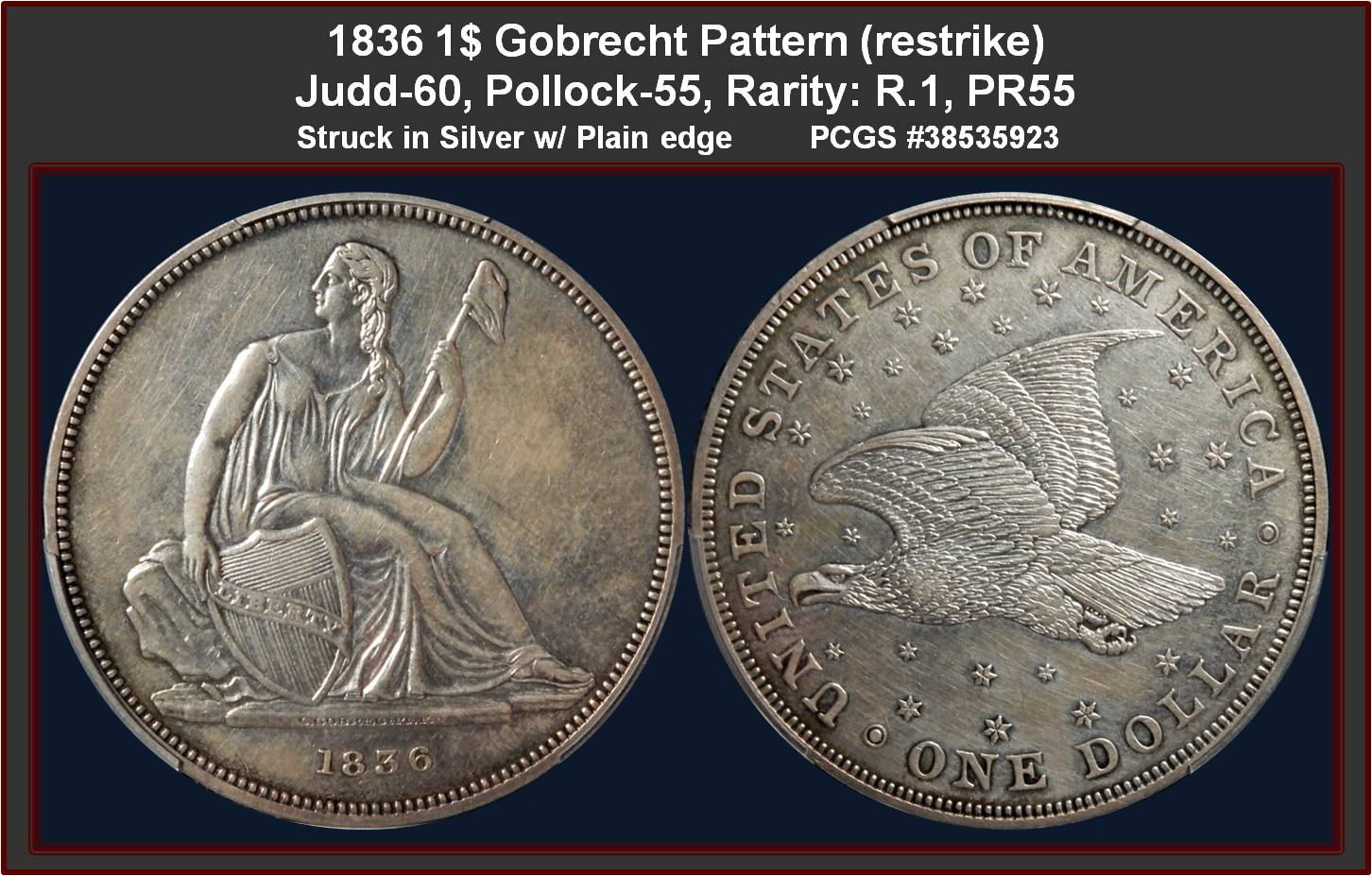
1836 1$
Judd-60, Pollock-55.
Rarity: R.1 Restrike issue.
Struck In Silver with Plain Edge
Obverse: Depicts Liberty seated on a rock holding a pole in her left hand with a cap of freedom perched on top, her right hand supports a shield draped with a ribbon inscribed LIBERTY. The entire obverse is free of legends otherwise, and the only device aside from Lady Liberty is the date below of 1836.
Reverse: There is an eagle in full flight, flying level in a starry field, with small and large stars. Surrounding the stars and eagle is UNITED STATES OF AMERICA / ONE DOLLAR with stops in between the denomination.
Comment: These were the first silver dollars struck for circulation since 1803, and although they were issued in tiny numbers the die was cast and in 1840 this series of silver dollars began production in earnest and these circulated more widely, although the designs were modified.
Christian Gobrecht was the third person to occupy the post of chief engraver at the Philadelphia Mint. His popularity is reflected in such terms used as “Gobrecht dollar” and “The Gobrecht Journal”. Among pattern coins his contributions are at once vital, beautiful, and far-reaching. Most known are his Liberty Seated coins, first made in Pattern form in this 1836 silver dollar, and continued across the denominations of half dime, dime, quarter dollar, half dollar, and silver dollar for years thereafter. Separately, Gobrecht's elegant flying eagle is an American numismatic icon. First used on the 1836 pattern dollar, it later appears on many other Patterns as well as regular issue 1857-1858 cents
This particular coin is quite impressive and desirable An lightly toned example with flashy surfaces and lovely antique silver-gray toning with deeper blue and russet accents surrounding the devices. The surfaces are sweet and smooth, with no detracting marks and the eagle's breast feathers are bold.
Provenance/ Appearance:
From Ira & Lee Goldberg June 2020 Pre-Long Beach Auction /Lot 654
|

|
|
View Coin
| J-346 |
United States
|
S$1 1863 J-346
|
PCGS PF 64 Brown
|

1863 1$
Judd-346, Pollock-418
Rarity: Low R.7, PR64 BN
Ex: Simpson
Also plate coin in the 8th addition of the Judd reference book
Struck in Copper with Reeded Edge
Obverse: The obverse die is the design used on regular-issue dollars in 1863.
Reverse: The reverse features the normal perched eagle design, with the addition of the scroll and motto IN GOD WE TRUST above the eagle's head as used in 1866.
Comment:
While traditionally called a "transitional" half dollar, this and other With Motto patterns were actually struck for the collector trade and were offered by the Mint with restrikes of other denominations as complete sets.
This is remarkably well-preserved example whose mellowed surfaces still retain a significant amount of underlying mint red. The fields are nicely mirrored with a strong presence of mint frost over the devices.
Pollock cites three auction appearances at the time of his reference work and two impounded specimens, in addition to two privately held specimens (the Bass and “Lemus” coins which have since been auctioned) plus one other example (that might be this coin) was also mentioned as having a 170“ die rotation as seen on this piece. Pollack cited that coin as held in a collection of a renowned Florida collector. The pedigree of the East Coast Collection auctioned in 2003 was at the time one of the most spectacular specialized collections of pattern dollars that Bowers and Merena had ever offer. They noted the collector had been assembled over the prior 16 years and the focus was the Liberty Seated motif patterns. This coin was the plate coin in the 8th addition of the Judd reference book
Provenance/Appearances:
Private sale Dec 2021; Prior From The Bob Simpson Collection Heritage Aug 2021 WFOM Signature Auction / Lot #3071, Prior
- ANR Sept 2003 Classic Sale – The East Coast Collection /Lot #54 ($12,650) NGC PR64:
- Superior Crouch June 1977 lot 505
- Stacks May 1970 Gaston DiBello Collection, Part II: Lot #403
-- JUDD reference book Plate Coin for Design in 7th and 8th editions
|

|
|
View Coin
| J-397 |
United States
|
S$1 1864 J-397
|
PCGS PF 64 Red Brown
|

1864 $1 Seated Dollar
Judd-397, Pollock-465
Rarity: R.6, PR64 RB.
Ex: Simpson.
Struck in copper with a reeded edge.
Obverse: The Liberty Seated design used in for the regular strikes for the year 1864.
Reverse: Similar to the regular design except with the motto IN GOD WE TRUST added above the eagle. This is the so-called transitional dollar with the With Motto reverse that was first adopted in 1866 .
Comment: The reverse clearly shows a scribe line above ST, but not above the E in UNITED. This matches the dies used for some 1871 patterns and regular issue proofs, thus establishing their striking period being later than 1864
Only a dozen or so examples are believed extant in copper. The surfaces are rich mint red with the occasional dab of blue interspersed. Sharply detailed throughout.
Provenance:
Ex: Bob Simpson Heritage Aug 2021 ANA WFOM Auction / Lot #3078
Prior Bowers & Merena May 1999 ( Harry W. Bass collection) / Lot # 1245 and purchased from Brinton T. Schorer, May 3, 1973
|

|
|
View Coin
| J-435 |
United States
|
S$1 1865 J-435
|
PCGS PF 63 Brown
|

1865 $1 Seated Dollar
Judd-435, Pollock-508
Rarity: Low R.7, PR63 BN
Struck in copper with a reeded edge.
Obverse: Die is the same as that of the regular issue 1865 Seated dollar
Reverse: Is that of the regular issue Seated dollar beginning 1866 with the motto IN GOD WE TRUST on a scroll over the eagle.
Comment:
About a dozen examples are known in copper with another 12 or so believed known in silver. The surfaces show subdued amber-brown patina with a few inoffensive carbon spots near the borders
Provenance/Appearances:
From Heritage Aug 2019 ANA World's Fair of Money - Chicago / Lot #4474: Prior
- Heritage Feb 2006 Long Beach / Lot #2482 (Passed);
- Heritage Aug 19 1995 American Numismatic Association Sale / Lot #8251;
- Bowers & Merena Jan 1999 (The Rarities Sale Dr. Wallace Lee Collection.) Lot #305
|

|
|
View Coin
| J-541 |
United States
|
S$1 1866 J-541
|
NGC PF 64 BN
|

1866 $1 Dollar
Judd-541, Pollock-606
Rarity: Low R.6, PR64 BN
Struck in copper with a reeded edge.
Obverse/Reverse: Copper strikes using the dies of the year
Comment:
Traditionally referred to as dies trial striking, these pieces are more than likely off-metal strikes that were deliberately produced for sale to collectors.
The surfaces have evenly mellowed, and while no traces of red remain there are equal parts of brown and blue patina present depending on how the coin is angled. Deeply mirrored fields with only a few faint carbon spots seen (almost exclusively on the obverse).
Provenance/Appearance:
Private Sale Houston Money Show Jan 2019; Prior Heritage Sept 2018 Long Beach Expo / Lot #3292
|

|
|
View Coin
| J-593 |
United States
|
S$1 1867 J-593
|
PCGS PF 63
|

1867 $1 Seated Dollar in Brass
Judd-593, Pollock-657
Rarity: High R.7, PR63
Struck in Brass with reeded edges
Obverse/Reverse: The obverse and reverse are struck from the regular issue dies for the 1867 Seated dollar,
Comment:
According to USPatterns.com, about a half-dozen examples are known in brass. The issue began appearing in auction catalogs in the 19th century in such offerings as lot 204 of the Woodside Collection (New York Coin & Stamp, 4/1892): "1867 Dollar: regular type: brass: proof: exceedingly rare." Even though five pieces were reportedly struck in brass, according to USPatterns.com there may have been even a couple more than that struck.
The surfaces are bright yellow-green, making it immediately obvious this is an off-metal striking. Faint iridescence is also seen over each side. The fields are adequately mirrored, each side shows faint evidence of hairlining, and there are a few small spots on the figure of Liberty.
Technical Diameter: 1.492 inches. Die alignment: 180°.. From Bowers Mar 96 Catalog
Provenance/Appearances:
From The Pacific Rim Collection, Heritage Nov. 2021 Signature® Auction Dallas / Lot #3748; Priors:
- Great Collections, Dec 2018 (lot # 649185)
- Prior Ex: Heritage Aug 2011 Chicago Auction / Lot #7735,
- Stacks-Bowers Feb 2008 The Rich Uhrich Collection / Lot # 1714;
- Bowers & Merena Feb 2006 (Rarities Sale) / Lot# 486
- John E. Drew Collection, Bowers and Merena Mar 1996, The Sebring and Garbe Collections / Lot #2061;
and in these last 2 Stacks & Bowers confirms this piece also was From
- Rarcoa's sale of the Harry X Boosel Collection, April 1972, / Lot #1057; and the
- Superior's ANA Convention Sale, August 1975, / Lot #1259;
- Bowers and Ruddy's sale of the Branigan Collection, August 1978, / Lot #1838; and
- Superior's session of Auction '79, / Lot #1626
|

|
|
View Coin
| J-652 |
United States
|
S$1 1868 J-652
|
NGC PF 63 CAMEO
|

1868 1$
Judd-652, Pollock-725
Rarity: High R.7, PR63 Cam CAC Endorsed
Struck in Aluminum with Reeded edge
Obverse and Reverse: The same designs that the Mint used to strike regular issue 1868 dollars.
Comment::
This is a beautiful Aluminum piece without the issues typical of Aluminum patterns with no lamination or oxidation. Deep reflective fields showcase the devices with a net cameo appearance.
Until the mid-1880s, when a new process to separate aluminum from its ores caused the price of the metal to plunge, aluminum was considered a precious metal. Today aluminum is common, but pattern silver dollar coinage remains quite precious to a large subset of pattern specialists.
Four or five complete aluminum dies trial sets were struck in 1868 at the instruction of Henry R. Linderman, Director of the Mint. One of these sets, in an original leather presentation case, was in the Garrett Collection sale in 1979, Lot 396. This set later appeared in the 1997 ANA sale as Lot 7289. Another nearly complete set (undoubtedly assembled rather than original) was offered as individual pieces in Bowers and Merena’s 1984 Arnold/Romisa sale. It was missing only the Nickel Three Cent and Five Cent pieces. Another complete set, an original set in the possession of descendants of Hugh McCulloch, Secretary of the Treasury in 1868, reportedly was sold privately in recent years [ Later appeared in the Eric P Newman Auction Heritage 2014 lot 3341 – 3456 and broken up and sold individually]. In addition to the 4-5 complete sets, apparently a few extra pieces of each denomination may have been struck, because today an estimated 6-8 specimens are believed known of each denomination. The 1st set was reported to have been auction by Ebenezer Locke Mason Oct 4 1870 Lot 1381, followed by 6 other recorded auctions in the 19th century with sets. In 1871 the set sold the prior year in 1870 was broken up and sold individually and believe the 1$ was resold in 1879.
Provenance/Appearance:
Private sale Oct 2022, No prior appearances can be trace.
|

|
|
View Coin
| J-763 |
United States
|
S$1 1869 J-763
|
PCGS PF 65 Red Brown
|

1869 1$ Seated Dollar
Judd-760, Pollock-848
Rarity R.7, PR65 RB
Ex: Simpson. .
Struck in copper with a reeded edge.
Obverse/Reverse: Regular die design as issue for the Seated Dollar.
.
Comment:
These pieces were deliberately struck by the Mint for sale to collectors as part of off-metal sets. Fewer than a half dozen are known today.
This GEM is the finest graded in any designation at either service.
About three or four Judd-763 examples are known, per USPatterns.com. Rather than dies trials, these were struck for sale to collectors.
Red and Brown surfaces reveal iridescent shades of magenta, peach-orange, cobalt-blue, and mint-green when rotated. A striking example and rare in this metal.
Provenance/Appearances:
From Heritage May 2023 CSNS Signature® Auction / Lot #4954
Ex: Important Selections from the Bob R. Simpson Collection, Part I (Heritage, 9/2020), /Lot #10239;
Stacks Jan 1994 / Lot #520
|

|
|
View Coin
| J-996 |
United States
|
S$1 1870 J-996
|
NGC PF 64
|

1870 Pattern Dollar.
Judd-996, Pollock-1127.
Rarity. High R.7, PR64
Ex: Lemus
Struck in Silver with a reeded edge
Obverse: Liberty seated facing left, her right hand resting on a shield and holding a ribbon, her left hand holding an olive branch, and a Liberty pole and cap in the background. 13 Stars surround her.
Reverse: The central motif on the reverse is the denomination 1 DOLLAR, surrounded by a broad wreath of cotton and corn, and STANDARD at the top..
Comment:
Pearly-dove grey overall with splashes of gold and bronze iridescence noted near the borders. Impressively sharp, the central elements feature satiny luster and contrast subtly with the icy reflectivity in the fields. Attractive and original with strong eye appeal for the assigned grade.
While USPatterns.com indicate about a dozen are know , in looking at auction records of the past 50 years, J996 appeared only about a half dozen unique pieces have been auctioned. This particular specimen, appeared 6 times by itself. I believe it is closer to a High R.7 rarity.
405.6 grains, Diameter: 1.491” Die alignment: 180°.
Provenance:/ Appearance:
Private sale 2/2023 Prior: From Stacks 2020 March / Lot #4477,
- Heritage Sept 2014 / Lot# 3577,
- The Lemus Collection, Queller Family Collection Part Two, Heritage Jan 2009 Fun / Lot#1776,
- Rusbar Collection (Bowers and Merena, 9/1990), lot 772.
- Bowers and Ruddy Rare Coin Review 44, p. 6;
- Steig Collection (Bowers and Ruddy, 9/1982), lot 1798; &
- Bowers & Ruddy Jul 1981 (William R. Sieck Collection) / Lot#256
|

|
|
View Coin
| J-988 |
United States
|
S$1 1870 J-998
|
PCGS PF 64 Red Brown
|
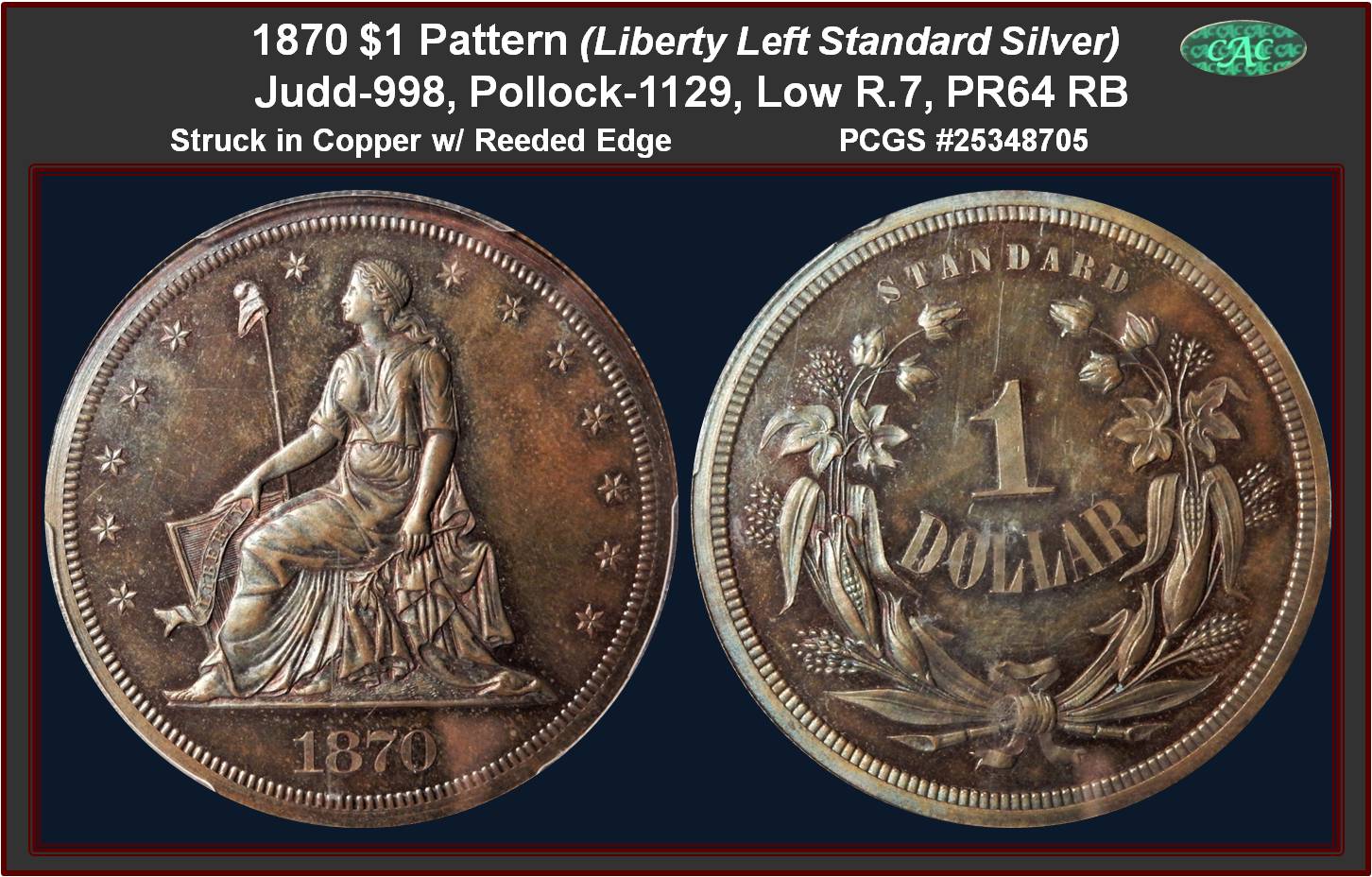
1870 $1 Standard Silver Dollar,
Judd-998, Pollock-1129,
Rarity: Low R.7, PR64 RB CAC Endorsed
Ex Denali
Struck in copper with a reeded edge
Obverse: Liberty seated facing left, her right hand resting on a shield and holding a ribbon, her left hand holding an olive branch, and a Liberty pole and cap in the background. 13 Stars surround her.
Reverse: The central motif on the reverse is the denomination 1 DOLLAR, surrounded by a broad wreath of cotton and corn, and STANDARD at the top..
Comment: About a dozen examples are believed known of this dollar pattern.
Both sides are more blue than red or brown, making an impressively toned dollar. The fields are deeply mirrored and enliven the patina even more. Fully struck
387.1 grains. Diameter: 1.489 inches. Die alignment: 180°.
Is interesting to note in March of 1994 Bowers writes
“…. The availability of J-998 has been grossly underestimated by the editors of the Judd pattern book. Although listed as Rarity-6, it is doubtful that as many as eight or nine could be traced. The piece offered here may be identical with one of the examples enumerated in the census below:
1) L. Merkin, March 1968, Lot 354, Proof; Stack’s, July 1986, Auction ‘86, Lot 474.
2) King Farouk; Bowers and Ruddy, December 1975, Kensington, Lot 1186.
3) King Farouk; Superior, June 1977, Crouch, Lot #513.
4) Rarcoa, 1973, F.U.N., Lot 630; Bowers and Ruddy; July 1981, Sieck, Lot 257.
5) J.C. Mitchelson; Connecticut State Library
….”
Provenance:/ Appearance:
Private sale 2/2019: Prior: Bowers & Merena Mar 1994 The Whitney P. Sunderland Collection / Lot 1459, Heritage Oct 2011 Pittsburgh / Lot #4577, Stacks March 2012 Baltimore Rarities Night Auction / Lot #4201
Ex Denali Collection (PCGS# 06645059 retired)
.
|

|
|
View Coin
| J-1005 |
United States
|
S$1 1870 J-1005
|
NGC PF 63 BN
|

1870 $1
Judd-1005, Pollock-1137
Rarity: Low R.6 PR63BN
Struck in copper with a plain edge.
Obverse: he obverse portrays a seated figure of Liberty with shield and olive branch. A scroll is draped over the shield with the word LIBERTY inscribed and a Liberty pole stands behind the shield. Thirteen stars surround the central devices, with the date in the exergue
Reverse: The reverse is the design used for regular-issue coinage in 1870 with the standing spread wing Eagle and IN GOD ER TRUST in Scroll above.
Comment:
Vibrant ice-blue toning covers deep glossy brown surfaces. Smooth and fully struck with muted underlying reflectivity yielding nice eye appeal.
Provenance/Appearance:
From The Collection of William Rau. Heritage April 2018 CSNS - Chicago / Lot #5071; Prior From Heritage May 2000 Central States Sale / Lot #7973
|

|
|
View Coin
| J-1007 |
United States
|
S$1 1870 J-1007
|
PCGS PF 65 Cameo
|
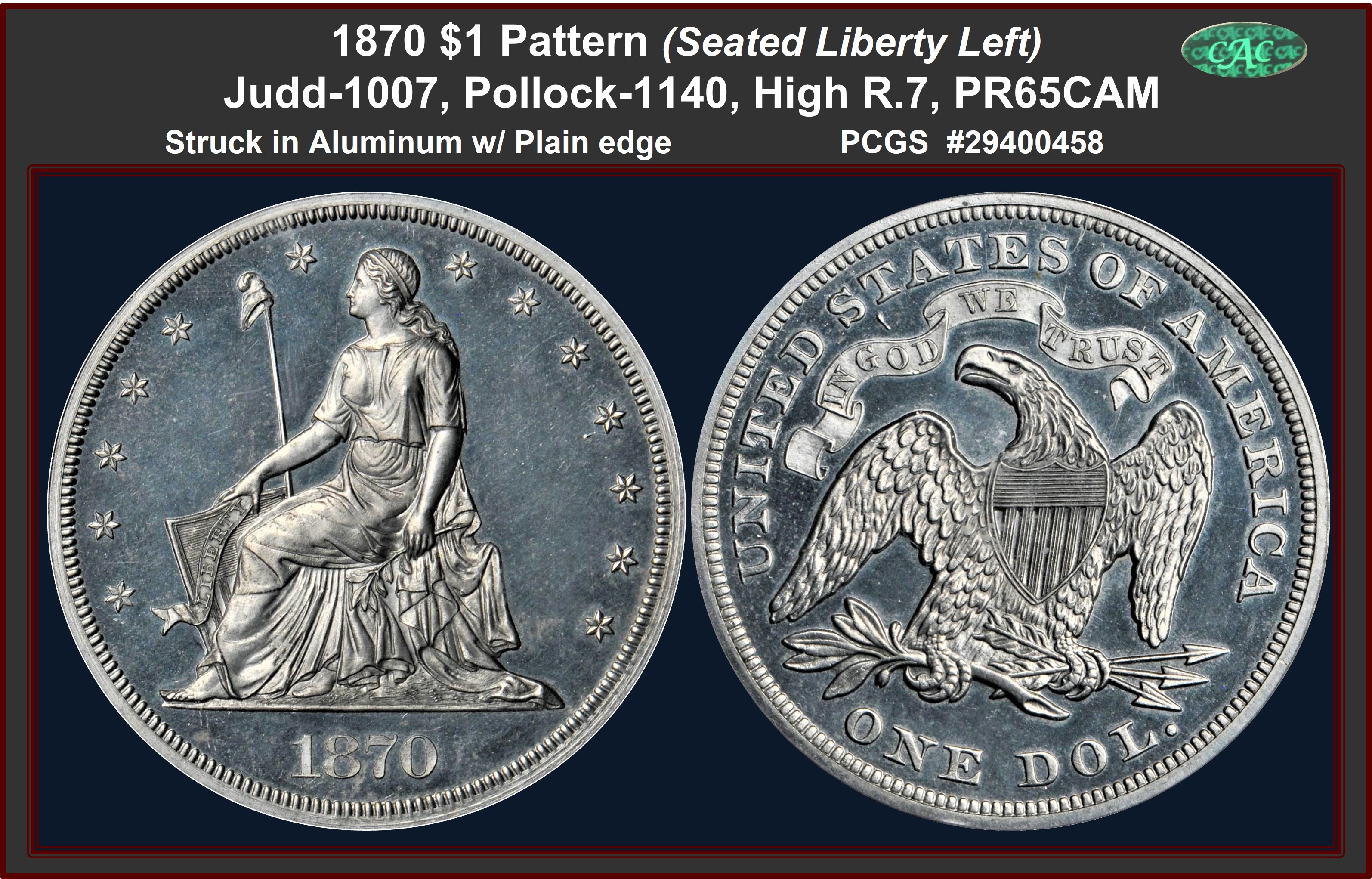
1870 $1
Judd-1007, Pollock-1140
Rarity: High R.7; PR65 CAM CAC Endorsed
Struck in Aluminum with a plain edge.
Obverse: The obverse portrays a seated figure of Liberty with shield and olive branch. A scroll is draped over the shield with the word LIBERTY inscribed and a Liberty pole stands behind the shield. Thirteen stars surround the central devices, with the date in the exergue
Reverse: The reverse is the design used for regular-issue coinage in 1870 with the standing spread wing Eagle and IN GOD ER TRUST in Scroll above.
Comment:
Each side is bright with the usual deeply reflective fields and thick mint frost over the devices. Exceptional quality.
The uspatterns.com website notes the following about Judd-1007: "This is William Barber's seated liberty design combined with the regular reverse die. Sets were available in silver, copper and aluminum with either reeded or plain edges. It is not known what price the Mint sold these for. This obverse was also combined with the 'Standard Silver' wreath reverse." The website notes just three or so examples are known in any grade.
Provenance/Appearance:
From The Pacific Rim Collection, (Heritage 11/2021) / Lot #3758; Priors
- The Star Mountain Collection, Central States (Heritage, 4/2018), lot #4493;
- Goldberg June 2014 Sale/ Lot #1638;
- Stacks 6/2012 Baltimore / Lot #4075 ($14,100),
- Heritage Jun 2011 /Lot #4435
- Heritage Oct 1990 Long Beach / Lot #1060 (PCGS PF64)
|

|
|
View Coin
| J-1008 |
United States
|
S$1 1870 J-1008 S$1 1870 J-1008 Simpson
|
PCGS PF 63
|
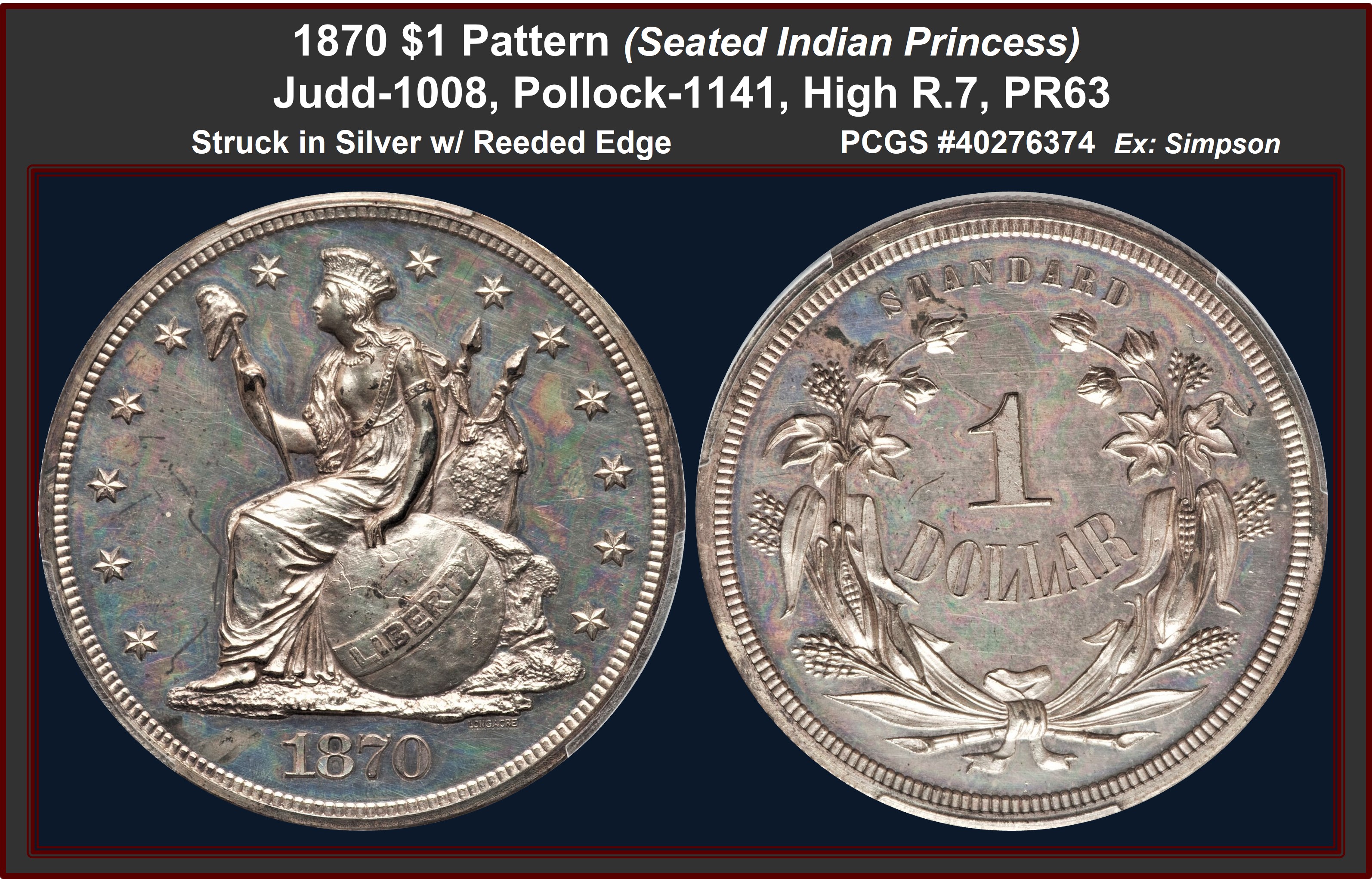
1870 $1 Standard Silver Dollar,
Judd-1008, Pollock-1141
Rarity: High R.7, PR63
Ex: Simpson.
Struck in silver with a reeded edge.
Obverse: Longacre's "Indian Princess" design, seated to left, liberty pole, topped with a Phrygian cap, in right hand, left hand on globe, Western Hemisphere depicted on globe, ribbon on globe reads LIBERTY, LONGACRE in tiny letters near globe, furled flags behind Liberty with 22 stars, 13 stars around the perimeter and the date is below.
Reverse: The reverse features the word STANDARD at the top with 1 / DOLLAR encompassed by a wreath of cotton and corn.
Comment: This design was apparently based on a sketch Longacre made prior to 1852, but it was not until 1870 that he made use of it and adapted it on a number of different pattern coins. Longacre’s name inscribed below the base believed to honor him as he died the previous year
Probably lacquered. Typical of these curious Standard Silver patterns, it lacks any mention of the country of origin. Lightly hairlined silver-gray surfaces exhibit blended iridescent accents. This piece may have been from the King Farouk collection with only few appearances of these pieces in the last 60 Years. One Piece is impounded in the Harry Bass collection at that ANA Museum.
Provenance/ Appearance:
From the Bob Simpson Collection Heritage Jan 2021 FUN / Lot #3185: Prior Ira & Larry Goldberg Auctioneers June 2000 (Dr. Jon Kardatzke Collection Part II) / Lot #1078, - appear to also be in Bowers and Ruddy Rare Coin review NO 26 Page 70- ($1495).
Kosoff May 1955 Fix Price List, Prior King Farouk
|

|
|
View Coin
| J-1011 |
United States
|
S$1 1870 J-1011
|
PCGS PF 64 Red Brown
|

1870 $1 Standard Silver Dollar
Judd-1011, Pollock-1144
Rarity: Low R.7, PR64 RB CAC Endorsed
Ex: New Millennium Collection.
Struck in copper with a reeded edge.
Obverse: James B. Longacre's Indian Princess design featuring Liberty seated beside a globe, wearing an Indian headdress with 13 stars around. The word LIBERTY is inscribed across the center of the globe and Liberty is holding a pole topped with Phrygian cap.
Reverse: Features 1 DOLLAR encompassed by a wreath of cotton and corn and the word STANDARD at the top.
Comment: This design was apparently based on a sketch Longacre made prior to 1852, but it was not until 1870 that he made use of it and adapted it on a number of different pattern coins.
The strike is bold, nearly in high relief. The obverse shows full red color while there are just a few dabs of brown and blue patina in the fields on the reverse. Magnification shows numerous specks of carbon on each side, which accounts for the less-than-Gem grade.
Many patterns were struck twice by the dies. What makes this piece unusual is that the reverse die rotated a few degrees clockwise between the two blows, leaving all the legends and devices of the first impression as a faint remnant just to the left of the dominant strike. There is also another “1 DOLLAR” reverse example with similar double effect - an 1870 Judd-996 in a recent Heritage auction.
Provenance/ Appearance:
From Legends Auction May 2021, The Regency Auction 45 Lot 384; Prior
- Heritage Nov 2003 New York Signature Auction /Lot 11164;
- Heritage April 2011 Rosemont CSNS / Lot #5570 “THE NEW MILLENIUM COLLECTION”
- Stacks Mar 1976 (Special Selection Garrett Collection) Lot 649, Garrett /JHU
|

|
|
View Coin
| J-1014 |
United States
|
S$1 1870 J-1014
|
PCGS PF 62
|
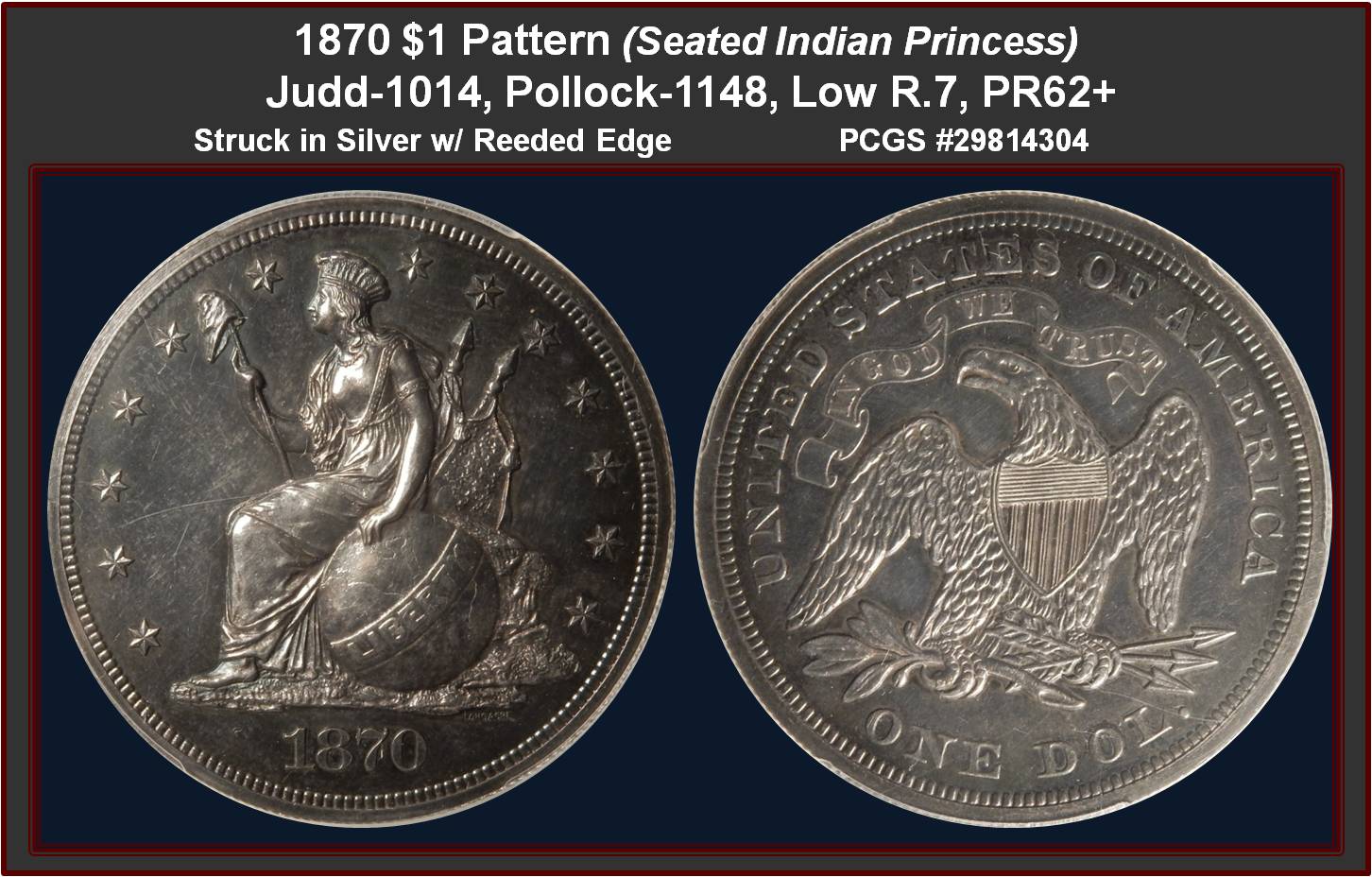
1870 $1 Standard Silver Dollar
Judd-1014, Pollock-1148
Rarity: Low R.7, PF62+
Struck in silver with a reeded edge.
Obverse: James B. Longacre's Indian Princess design featuring Liberty seated beside a globe, wearing an Indian headdress with 13 stars around. The word LIBERTY is inscribed across the center of the globe and Liberty is holding a pole topped with Phrygian cap. Longacre’s name inscribed below the base believed to honor him as he died the previous year
Reverse: The reverse is of the regular issue Liberty Seated dollar.
Comment:
James B. Longacre Indian Princess design was another entry in the “Seated Liberty” motif. This design first appeared on pattern coins in 1870 and continued on various denominations through 1873. Longacre never saw a completed coin with his design. The artistry for this work was actually completed many years earlier, with sketches of this design known circa 1852. LONGACRE is spelled out at lower right obverse and believed included as an honer to him as he died in 1869.
Gun-metal blue peripheral toning surrounding lightly golden centers. All details are strongly impressed and the fields retain their mirror finish through the toning.
A superb quality example of this seldom seen pattern.
Provenance/Appearance:
Private dealer sale Jan 2016, Prior From the T. Giordano collection (purchased by Giordano in 1959 and is reported to have been in his collection until sold)
|

|
|
View Coin
| J-1017 |
United States
|
S$1 1870 J-1017
|
NGC PF 66 BN
|
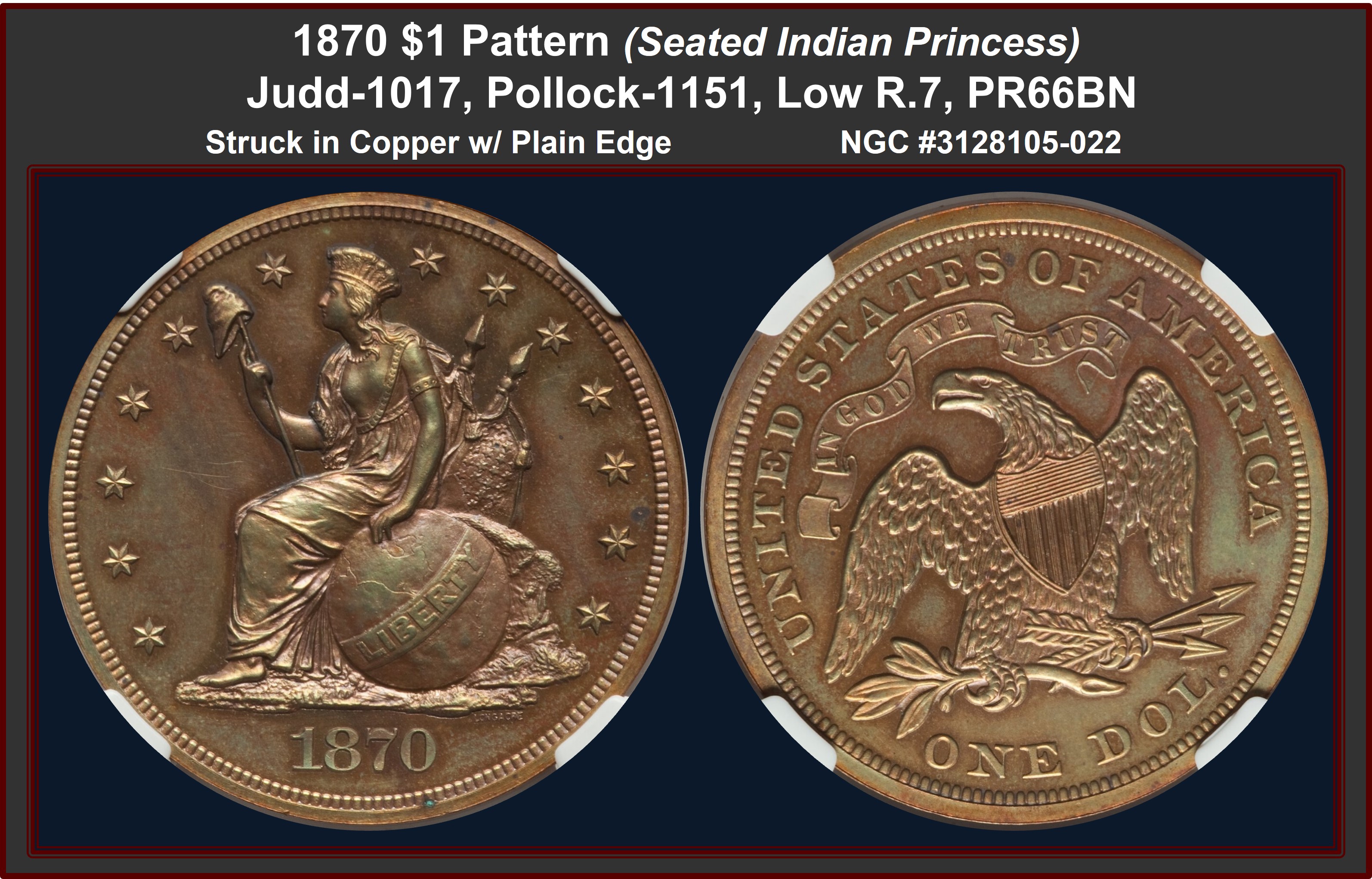
1870 $1 Seated Princess
Judd-1017, Pollock-1151
Low R.7, PR66 BN
Struck in copper with a plain edge.
Obverse: James B. Longacre's Indian Princess design featuring Liberty seated beside a globe, wearing an Indian headdress with 13 stars around. The word LIBERTY is inscribed across the center of the globe and Liberty is holding a pole topped with Phrygian cap. Longacre’s name inscribed below the base believed to honor him as he died the previous year
Reverse: The reverse is of the regular issue Liberty Seated dollar.
Comment:
Fewer than a dozen examples are known of this pattern dollar. For a coin designated as Brown this piece has a remarkable vibrancy. The fields are deeply reflective and each side has light gray-lilac color. Two light spots are located near the top of the reverse. An exceptional Indian Princess dollar.
Die Rotation 170Deg
Provenance/Appearance:
Private dealer sale Jan 2022, Prior
-From The Pacific Rim Collection, Heritage Nov 2021 Signature® Auction / Lot #3761;
-Ex: Central States Signature (Heritage, 4/2012), lot 5416;
-Ex Bob Simpson Stacks and Bowers August 2011 Chicago ANA Rarities Night / Lot 7504 ( Did not sell),
-Bowers & Merena Nov 1992 (Robert W. Miller, Sr) / Lot #1087 (PCGS 64BN)
-Superior Aug 1990, Auction 90 /Lot #1430 (PCGS 64BN)
|

|
|
View Coin
| J-1018 |
United States
|
S$1 1870 J-1018
|
PCGS PF 65
|

1870 $1 Dollar (Indian Princess)
Judd-1018, Pollock-1153,
Rarity: R.8, PR65
Ex: Simpson
Struck in Aluminum with a reeded edge.
Obverse: James B. Longacre's Indian Princess design featuring Liberty seated beside a globe, wearing an Indian headdress with 13 stars around. The word LIBERTY is inscribed across the center of the globe and Liberty is holding a pole topped with Phrygian cap. Longacre’s name inscribed below the base believed to honor him as he died the previous year
Reverse: The reverse is of the regular issue Liberty Seated dollar.
Comment:
This Gem proof is one of likely three examples known of this rare issue. The surfaces are light champagne-gold and show no mentionable distractions of post-Mint origin. A small raised planchet mark about nine dentils left of the date, near the rim, is typical of aluminum coinage, both pedigree marker and evidence of the recalcitrant nature of the metal. We also notice three tiny spherical marks in the obverse field between Liberty and star 3.
Provenance/Appearance:
Private dealer sale Jan 2023, Prior
- Ex: Bowers & Ruddy Oct 1977 (Fairfield Collection) / Lot#50;
- Steve Ivy Jan 1978 ( CW Henderson Sale) / Lot #1059:
- University Park Sale (Steve Ivy, 3/1981), / lot #1510;
- Central States Signature (Heritage, 5/2003), / Lot#7108, as PR64 NGC, which realized $29,900;
- Bob Simpson Sale, Heritage Nov 2020 / Lot #3195;
- Heritage April 2021 Central States / Lot #5222
|

|
|
View Coin
| J-1022 |
United States
|
S$1 1870 J-1022
|
PCGS PF 62
|

1870 $1 Seated Dollar
Judd-1022, Pollock-1157
Rarity: Low R.7, MS62
Ex: Simpson.
Struck in nickel with a reeded edge.
Obverse/Reverse: The regular-issue Seated Liberty dies for the year.
Comment:
Not only is this one of the few large-size patterns struck in this metal-edge combination, it is also one of the only patterns known to have been struck from both proof and circulation-strike dies. This Mint State representative features brilliant surfaces that are lustrous rather than flashy or reflective, with considerable softness around the rims. Probably fewer than a half dozen Judd-1022 pieces exist, both formats included.
The Farouk Collection contained two Mint State examples, and per Heritage, the only certified business strikes are this MS62 Simpson coin and an MS66 from the Denali Collection.
Provenance/Appearances:
From The Pacific Rim Collection Heritage Nov 2021 Signature® Auction / Lot #3487; an just prior Selections From the Bob R. Simpson Collection, Part I (Heritage, 9/2020), Lot #10264. Earlier Provenances as Ex: Possibly King Farouk Palace Collection Sale (Sotheby's 2/1954), lot 1839; possibly Gaston DiBello Collection (Stack's, 5/1970), lot 412; possibly Dr. Walter Lee Crouch Collection (Superior Galleries, 6/1977), Lot #517 (No Photos to Confirm PF60); Father Flanagan's Boys Home Sale (Superior Galleries, 5/1990), Lot #3338 ($5500);
|

|
|
View Coin
| J-1133 |
United States
|
S$1 1871 J-1133
|
PCGS PF 64
|
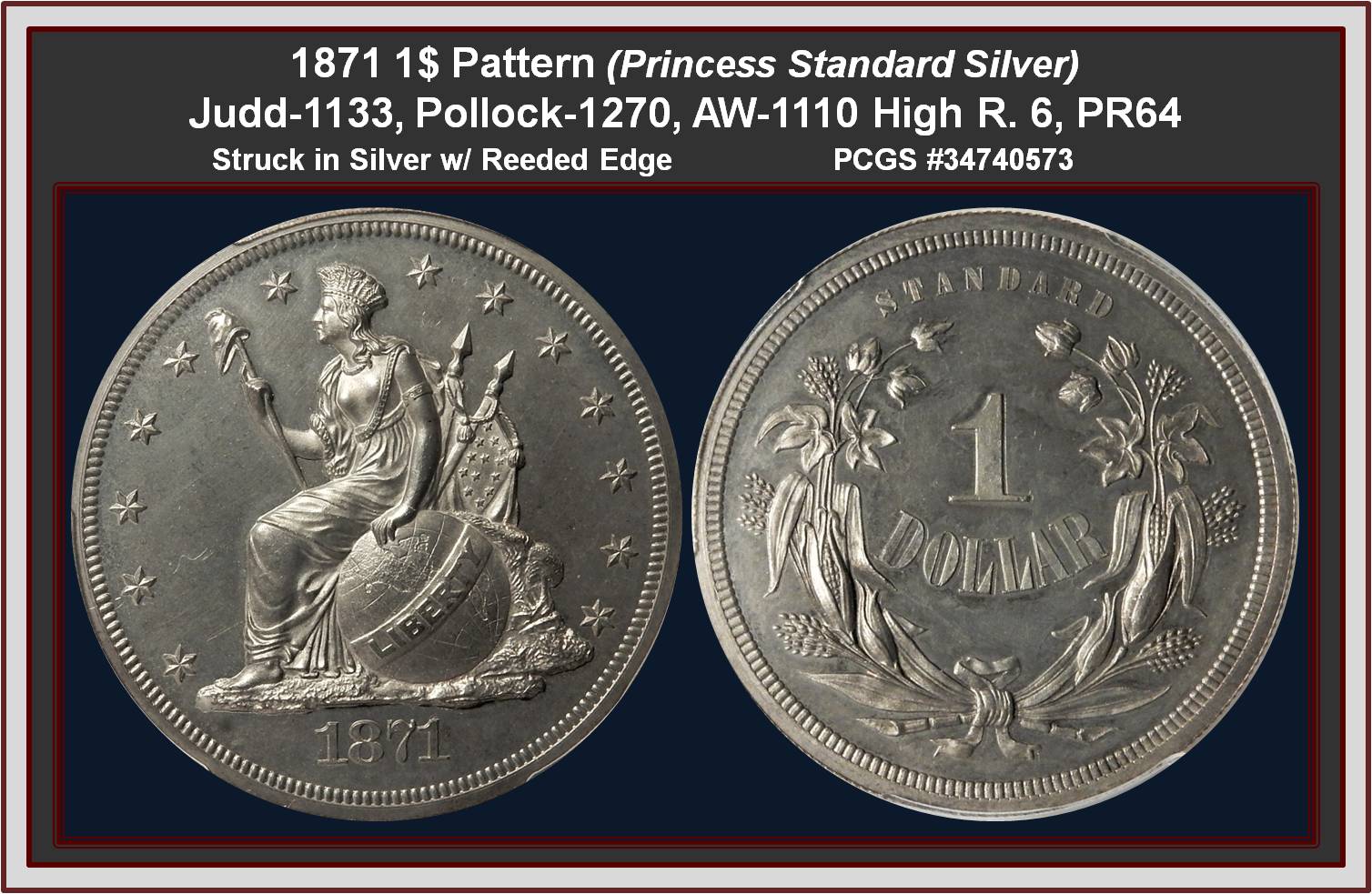
1871 1$ Princess Standard Dollar
Judd-1133, Pollock-1270
Rarity: High R.6, PR64
Struck in Silver with reeded edge
Obverse: Features James B. Longacre's Indian Princess design where a seated Liberty is facing left, wearing an Indian headdress and supporting a liberty pole with her right hand. Her left hand, rests on a globe inscribed LIBERTY. Behind her is a flag ornamented with 13 stars. Also, thirteen larger stars surround, the date 1871 is at the bottom.
Reverse: On the reverse, the denomination 1 DOLLAR situated within a wreath of cotton and corn with STANDARD above.
Comment:
This an overall very attractive piece appearing with a high relief SEATED LIBERTY with nicely reflective fields.
Typical of patterns using this reverse motif design .. there is no reference to the UNITED STATES OF AMERICA as the obverse seated liberty are surrounded by Stars
Believe this piece is from a 1995 auction with out a slab – the coin characteristics as
402.2 grains. Diameter: 1.494 inches. Die alignment: 180°
Provenance/Appearances:
Private transaction April 2018: Prior possibly Bowers and Merena Nov 1995 The Rogers M. Fred, Jr. Collections / Lot # 2293 (PF63) w/ notation obtained from Julian Feidman
|

|
|
View Coin
| J-1135 |
United States
|
S$1 1871 J-1135
|
PCGS PF 65 Brown
|
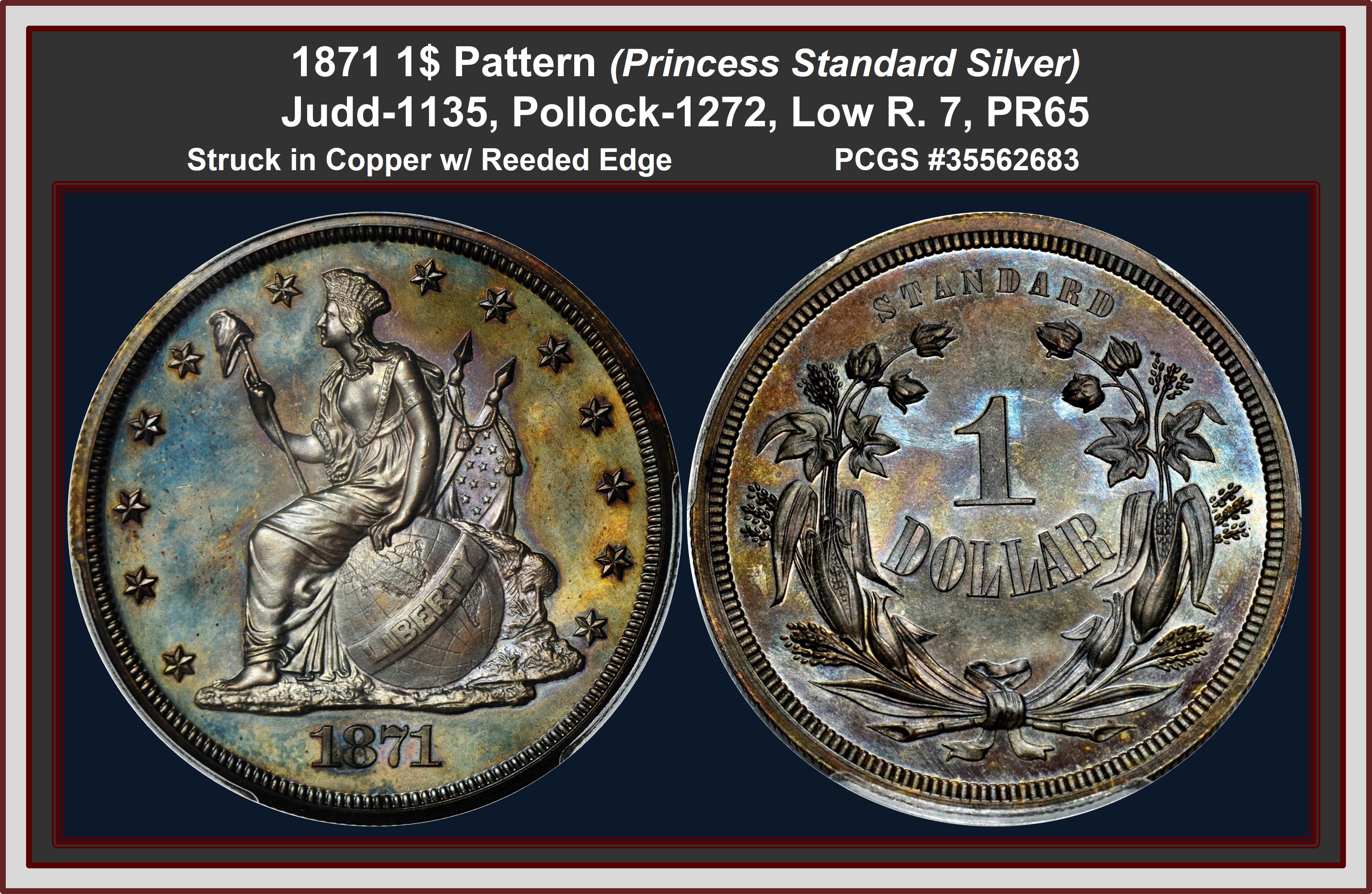
1871 1$ Princess Standard Dollar (Copper)
Judd-1135, Pollock-1272
Rarity: Low R.7, PR65
Struck in Copper with reeded edge
Obverse: Features James B. Longacre's Indian Princess design where a seated Liberty is facing left, wearing an Indian headdress and supporting a liberty pole with her right hand. Her left hand, rests on a globe inscribed LIBERTY. Behind her is a flag ornamented with 13 stars. Also, thirteen larger stars surround, the date 1871 is at the bottom.
Reverse: On the reverse, the denomination 1 DOLLAR situated within a wreath of cotton and corn with STANDARD above.
Comment:
Marbled deep rose and autumn-brown patina gives way to a vivid array of multicolored iridescence under a light. The fields are reflective and support satiny, fully impressed design elements.
Typical of patterns using this reverse motif design .. there is no reference to the UNITED STATES OF AMERICA as the obverse seated liberty are surrounded by Stars
Provenance/Appearances:
Provenance: Stacks & Bowers Apr 2022 Auction Lot # 3199 ; From Heritage's sale of the Pacific Rim Collection, November 2021 Signature Auction, lot 3765; Goldberg Auctions June 2018 Pre-Long Beach / Lot #1840 (AS NGC 64RB)
|

|
|
View Coin
| J-1138a |
United States
|
S$1 1871 J-1138a
|
NGC PF 62
|

1871 $1 (Indian Princess)
Judd-1138a, Pollock-1276,
Rarity; High R.7 - R.8, PR62
Ex: Farouk
Struck in silver with a reeded edge
Obverse: Chief Engraver James Barton Longacre's Indian Princess motif with 13 stars around the border. Liberty is seated left wearing a Native American headdress, her left hand resting atop a globe inscribed LIBERTY and her right hand supporting a liberty pole. Two flags are behind the portrait, one of which is ornamented with 13 stars, and the date 1871 is below.
Reverse: The same design that the Mint used to strike regular issue 1871 Liberty Seated silver dollars.
Comment:
This is an extremely scarce pattern with probably no more than five pieces known, according to USPatterns.com. This piece's brightness in part derives from having been cleaned, and in part from the deep, flashy mirrors in the fields. The surfaces are mostly brilliant with an occasional reddish-brown smudging of color, mostly seen on the right side of the obverse.
Several earlier examples of the 1138a were mis label in auctions as J1145 which has 22 stars in the flag behind Liberty.
On the May 2009 Heritage auction they included an Abe Kosoff envelope with the Palace Collection printing and card of sale to F.M. Stirling (Previous owner) with Kosoff's signed attestation. Since that 2009 sale of the Stirling collection, subsequent owners disregard this piece of history and the card seems lost now after this piece changed hands several times.
Provenance/Appearances:
From Heritage Jan 2022 FUN Signature® Auction - Orlando / Lot #4275 Prior
- Ex: King Farouk; Palace Collections of Egypt (3/1954), part of lot 1876; (Mis Labelled)
- Abe Kosoff; private sale to Frank M. Stirling, 9/1955;
- Frank M. Stirling Collection (Heritage, 5/2009) /Lot #1428;
- The Jarosi Collection ANA Signature (Heritage, 8/2010) /Lot #3723; and
- Heritage June 2021 Signature Auction / Lot #3246.
A comment on USpattern.com site stated that this piece may have been part of the Woodin-1914 ANS exhibit
|

|
|
View Coin
| J-1142 |
United States
|
S$1 1871 J-1142
|
PCGS PF 64 Red
|

1871 $1 Standard Dollar
Judd-1142, Pollock-1284
Rarity: High R.7, PR64 BN:
Ex: Bass, Pollock plate coin for P1284.
Struck in copper with a plain edge
Obverse: Features James B. Longacre's Indian Princess design where a seated Liberty is facing left, wearing an Indian headdress and supporting a liberty pole with her right hand. Her left hand, rests on a globe inscribed LIBERTY. Behind her is a flag ornamented with 22 stars. Also, thirteen larger stars surround, the date 1871 is at the bottom.
Reverse: On the reverse, the denomination 1 DOLLAR situated within a wreath of cotton and corn with STANDARD above
Comment:
This is the 1st Seated Liberty design by Longacre with 22 stars on the flag vs the prior 13.. About five examples of this variety are known, according to USPatterns.com. Nearly a quarter century ago, Andrew W. Pollock, III, reported three distinct examples with the possibility of a fourth known. Heritage noted an incorrect statment in their Nov 21 Auction catalog that this piece “was said to be the Pollock plate coin, per the Bass catalog, but it does not appear to be an exact match”, However, in comparing images it is an exact match to Pollock’s figure 371 and indeed was the BASS piece..
Technical Aspects: Weight: 354.8 grains. Diameter: 37.8 mm. Die alignment: 180°.
Provenance/Appearances:
From The Pacific Rim Collection, Heritage Nov. 2021 Signature® Auction Dallas / Lot #3766; Prior Central States Signature (Heritage, 4/2018), /lot #4495, Bowers and Merena 10/27/2000 The Robert W. Schwan Collection Sale /Lot #2028 ($4600), and from Harry W. Bass, Jr. Collection (Bowers and Merena, 5/1999), / lot #1261; with prior notation of Ex: Brinton T. Schorer (5/3/1973)
|

|
|
View Coin
| J-1145 |
United States
|
S$1 1871 J-1145
|
PCGS PF 63 Ultra Cameo Ultra Cameo
|
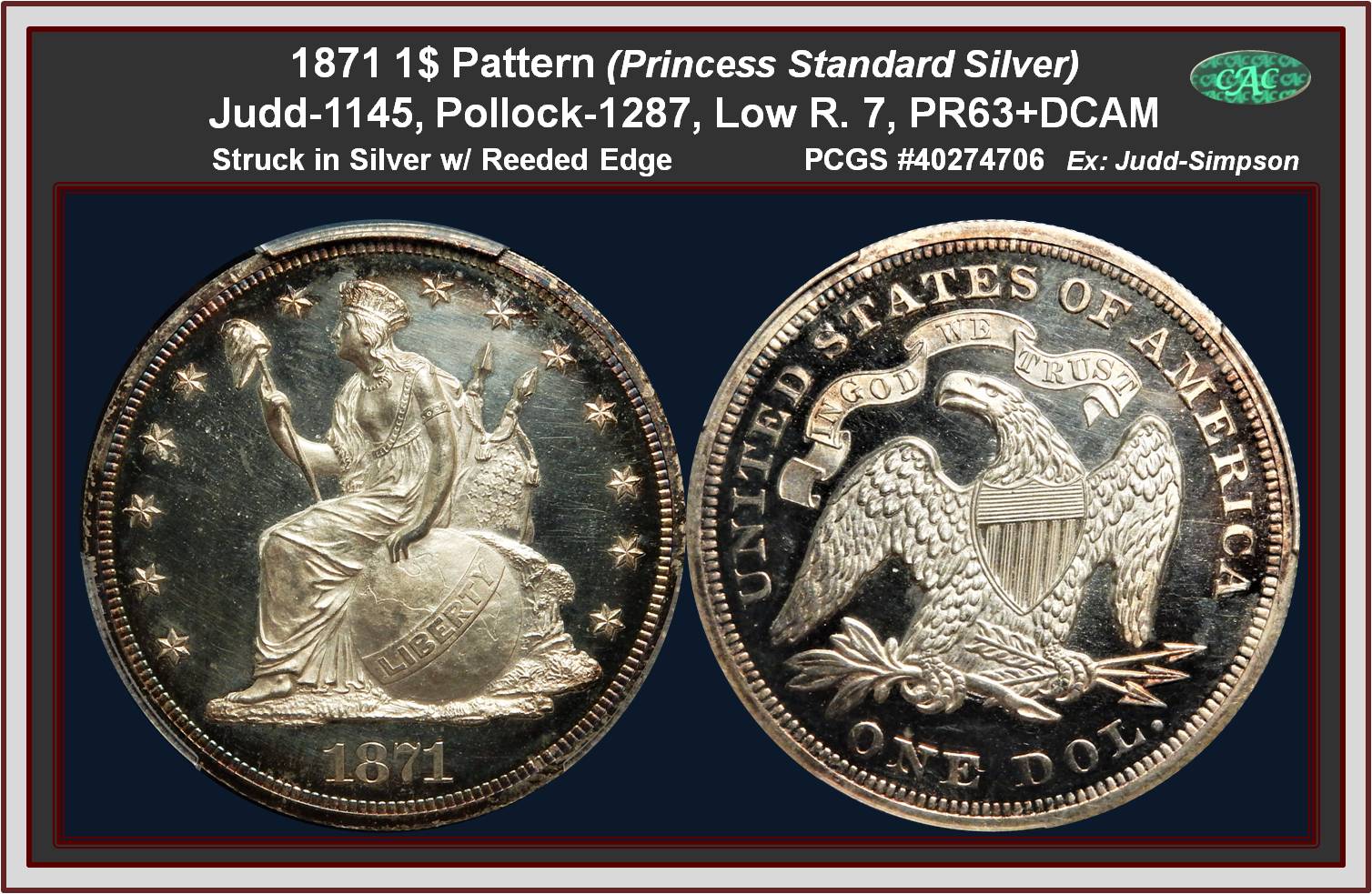
1871 $1 Silver Dollar,
Judd-1145, Pollock-1287
Rarity: Low R.7, PR63 Deep Cameo CAC Endorsed,
Ex: Judd-Simpson.
Struck in silver with a reeded edge.
Obverse: The obverse features Longacre's design for Seated Liberty facing left, wearing an Indian headdress and supporting a liberty pole with her right hand. Her left hand rests on a globe inscribed LIBERTY. Behind her is a flag ornamented with 22 stars. Thirteen stars surround, the date 1871 is at the bottom.
Reverse: The reverse is from the die used for regular-issue Liberty Seated dollars.
Comment:
These patterns were distributed as part of complete sets, half dime through dollar. About a dozen examples are known, according to USPatterns.com. This impressive Select Uncirculated proof with Deep Cameo contrast. This piece per the label can be traced back to the collection of Dr. J. Hewitt Judd, author of the standard reference on United States pattern, experimental, and trial coinage. Rings of golden-russet and cobalt-blue toning surround the borders, while the centers are considerably lighter. Eye appeal is phenomenal for this Deep Cameo proof.
Heritage noted that of the 2 of the know pieces are impounded by the ANS and Durham Western Heritage Museum.
Provenance/Appearances:
From the Bob Simpson Collection Part 4, Heritage April 2021 Central States Signature Auction / Lot #4240; Prior possible the piece offered The Magnolia Collection, Spink/Smythe May 2011 /Lot 19 (As PCGS PR62)
|

|
|
View Coin
| J-1148 |
United States
|
S$1 1871 J-1148
|
NGC PF 65 BN
|
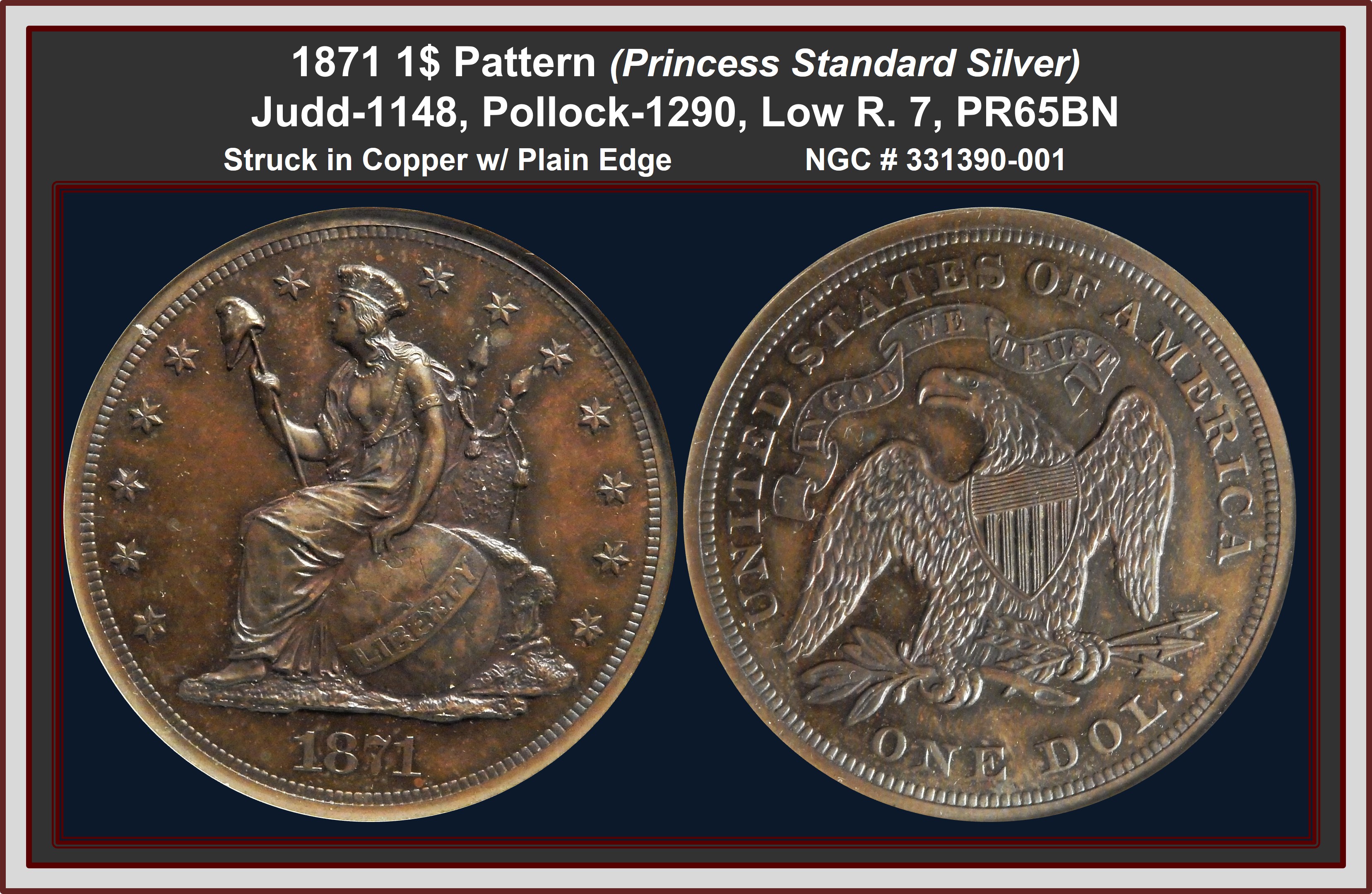
1871 $1 (Indian Princess Silver Dollar)
Judd-1148, Pollock-1290
Rarity: Low R.7, PR65 BN
Ex Judd
Struck in Copper with Plain Edge
Obverse: James Longacre's seated Indian Princess. Liberty wearing a feathered headdress sits, supporting a globe, showing the North and South American landmass, a ribbon inscribed LIBERTY across. She holds a pole with a Liberty Cap, and two flags behind. Thirteen stars around, date below.
Reverse: The standard Seated Liberty Reverse for year with Spread Wing Eagle and Motto.
Comment:
Longacre's design is struck in stark, high relief, its devices in full 3D against the smoothness of the surrounding fields. Flashing coppery surfaces give this coin the look of a bronzed medal struck during this time at the mint. Pleasingly toned with deep olive-brown surfaces that have accents of pale blue, lilac, and iridescence. A few ancient flecks are seen identifying this GEM. A single spot between the left wing and the letter O on the scroll will serve to identify this piece.
170Deg Die rotation
Provenance/Appearances:
Private Sale Jan 2022; Prior
- Legends Coin Auction May 2020 Auction #38 / Lot #304 ($7000),
- Great Collections, Oct 2016 / ID: 395028
- The Jones Beach Collection, Heritage Jan 2007 FUN Auction/ Lot #1473,
- Heritage Jan 1999 (FUN) /LOT 7534 (PASSED) ;
- Heritage Jun 1998 (Long Beach) /Lot #6627 ($6037);
- Superior Sept 1996 (The Gilbert Steinberg Collection) / Lot #732 ($5995)
- Horn - Jess Peters Jan 1975 ANA Lot 764 : EX Judd
|

|
|
View Coin
| J-1214 |
United States
|
T$1 1872 J-1214
|
PCGS PF 63
|

1872 $1 Commercial
Judd-1214, Pollock-1355
Rarity: High R.7
Ex: Eliasberg-Simpson
Struck in silver with a reeded edge
Obverse: Liberty is seated on a world globe, inscribed LIBERTY, facing left, and wearing an Indian headdress. The date 1872 is below and 13 stars surround the top. Liberty is holding a pole topped by a Phrygian cap in her right hand and her left hand is along her side resting on the globe. Two flags flank her with one displaying 13 stars.
Reverse: The denomination “COMMERCIAL DOLLAR” with the specific weight, 420 GRS, and the quality ,900 FINE, are inscribed in the center of a wreath of olive branches. The motto “GOD OUR TRUST” in inscribes on a scroll at the bottom and UNITED STATES OF AMERICA is at the top rim. Two cornucopias are crisscross between the words COMMERICAL and DOLLAR
Comment:
This Select proof is well-struck and lightly toned in rose hues. A few scattered ticks and hairlines are trivial but account for the grade.
This the William Barber's lower-relief adaptation of James B. Longacre's Indian Princess design, used posthumously after Longacre's death on January 1, 1869. There were a few differences one being only 13 stars in the flag vs. Longarce’s 22. Of note is that about ½ of the stars are double punched and some being significantly off center.
Per Bower's 1996 catalog the piece Weight is 419.9 grains and Diameter is 1.490 inches.
Provenance:
Ex: Ex: H.P.Smith (S.H. Chapman 5/1906), Clapp, Louis Eliasberg SR., Bowers and Merena May 1996 / Lot#292 (Sold $7,920); Bob R. Simpson Heritage Nov 2020 / Lot #3219
|

|
|
View Coin
| J-1216 |
United States
|
T$1 1872 J-1216
|
NGC PF 65 BN
|
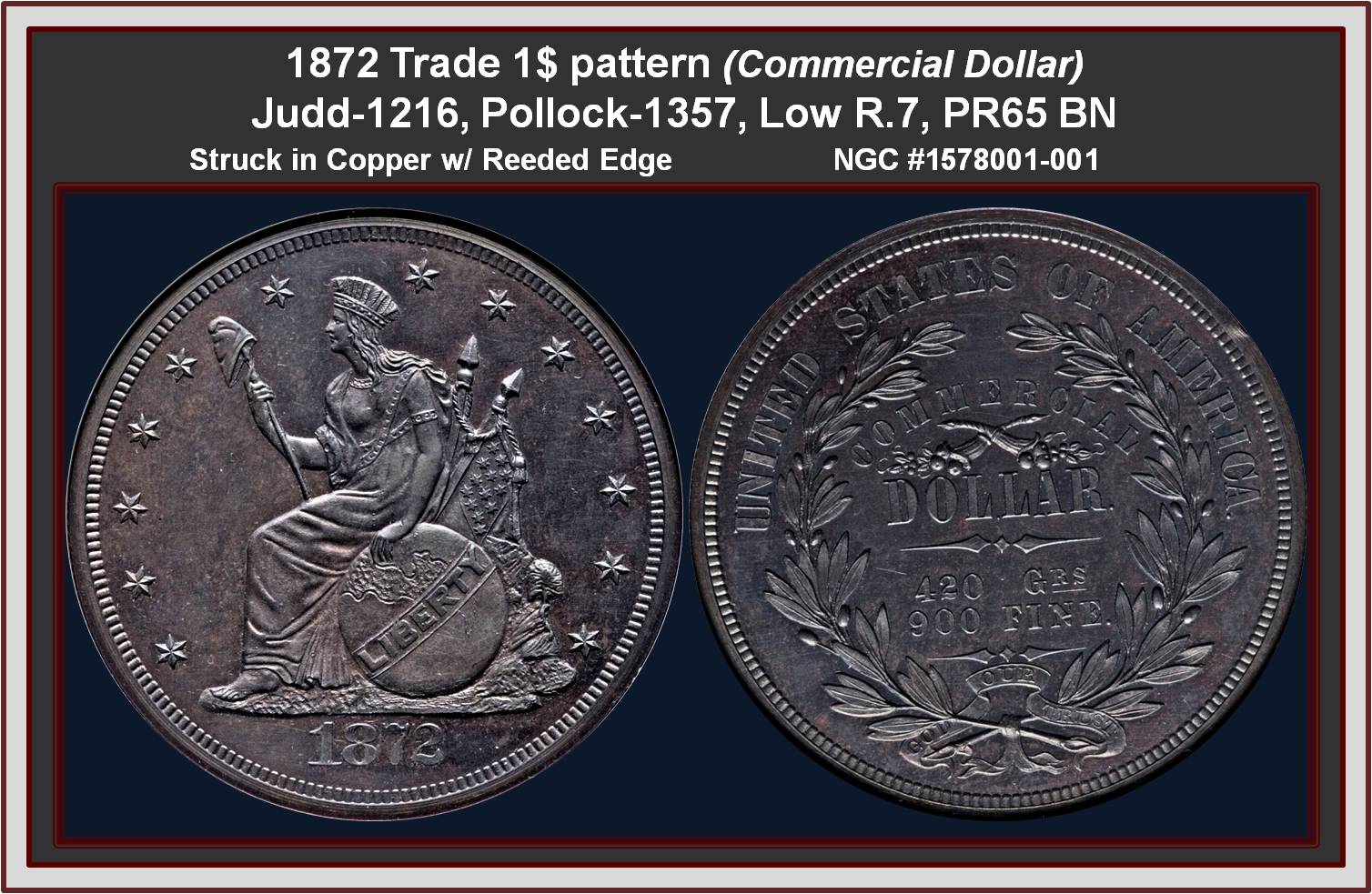
1872 $1 Commercial
Judd-1216, Pollock-1357
Rarity: Low R.7 PF65BN
Struck in copper with a reeded edge.
Obverse: Liberty is seated on a world globe, inscribed LIBERTY, facing left, and wearing an Indian headdress. The date 1872 is below and 13 stars surround the top. Liberty is holding a pole topped by a Phrygian cap in her right hand and her left hand is along her side resting on the globe. Two flags flank her with one displaying 13 stars.
Reverse: The reverse has UNITED STATES OF AMERICA above an olive wreath. GOD OUR TRUST is below the wreath on a scroll, and within the wreath are the legends COMMERCIAL / DOLLAR / 420 GRs / 900 FINE Two cornucopias are crisscross between the words COMMERCIAL and DOLLAR
Comment:. USPatterns.com estimates that about a half dozen copper strikings are known today. Deep blue-gray patina barely covers the underlying mint red. Fully struck throughout.
This the William Barber's lower-relief adaptation of James B. Longacre's Indian Princess design, used posthumously after Longacre's death on January 1, 1869. There were a few differences one being only 13 stars in the flag vs. Longarce’s 22. Of note is that about ½ of the stars are double punched and some being significantly off center.
Provenance/Appearances:
Private Transaction Prior: From The Siegel Collection,. Heritage April 2017 CSNS Chicago / Lot #5112 ,
Possible Bowers & Merena Jan 1997 (Rarities Sale) / Lot #479;
Possible Bowers & Merena Nov 1995 (Rogers Fred and Peter Ward, M.D. Collections) / Lot #2326
--------------------------------------------------------------------------------
I like to add the following - Numismatic Reflections by Q. David Bowers
The Commercial dollars are very special patterns. They are the work of John Jay Knox, himself a numismatist, who crafted the wording for the Coinage Act of 1873. This was endorsed by Congress and passed easily. Some years later, when the price of silver dropped on world markets, and western mining interests suffered because Uncle Sam wasn't buying enough metal in quantity to support the market, the bill was called the "Crime of 1873." But, careful reading of it will show that it was well thought out. ��Not to worry, some years later in 1878 the western mining interests triumphed, influenced Congress to enact the boondoggle Bland-Allison Act, and the government began buying millions of ounces of unwanted silver metal each year and coin them into what we now know as Morgan dollars. There was no commercial need for dollars at the time, as they circulated only in a few places and not in quantity. Accordingly, hundreds of millions of them piled up in Treasury vaults. This turned out to be an absolute delight for numismatists of generations later, as now Mint State Morgan dollars are very plentiful, at least for the majority of issues. Incidentally, the very same thing is happening today with Presidential dollars and Sacagawea dollars-zillions of them are being minted, they are not seen in circulation, and somewhere vaults must be bulging with them!
|

|
|
View Coin
| J-1219 |
United States
|
T$1 1872 J-1219
|
PCGS PF 62
|

1872 1$ Commercial Dollar
Judd-1219, Pollock-1360
Rarity: Low R.7; PR62
Struck in silver with a reeded edge
Obverse: The obverse is the regular design for the Seated Liberty dollar.
Reverse: The reverse has a laurel wreath with UNITED STATES OF AMERICA around. The wreath stems are tied by a bow, and intertwined with a ribbon inscribed GOD OUR TRUST. Inside, COMMERCIAL and DOLLAR are separated by a cornucopia with 420 GRS 900 FINE on two lines below.
Comment:
About 15 examples of this pattern variety are known, and at least three of those are held in museums. Steel-gray toning embraces both sides, though areas of lighter straw-gold persist, especially on the reverse. Well struck and unblemished with eye appeal that exceeds the numerical grade.
Reciting on of the many Numismatic Reflections by Q. David Bowers
The Commercial dollars are very special patterns. They are the work of John Jay Knox, himself a numismatist, who crafted the wording for the Coinage Act of 1873. This was endorsed by Congress and passed easily. Some years later, when the price of silver dropped on world markets, and western mining interests suffered because the government wasn't buying enough metal in quantity to support the market, the bill was called the "Crime of 1873." But, careful reading of it will show that it was well thought out. ��Some years later in 1878 the western mining interests triumphed, influenced Congress to enact the Bland-Allison Act, and the government began buying millions of ounces of unwanted silver metal each year and coin them into what we now know as Morgan dollars. There was no commercial need for dollars at the time, as they circulated only in a few places and not in quantity. Accordingly, hundreds of millions of them piled up in Treasury vaults.
Provenance/ Appearances:
From Heritage Jan 2021 FUN Signature Auction / Lot #4908; Prior
- Ex: Heritage Aug 2007 Milwaukee ANA /Lot #2745;
- Stacks Nov 2007 Amherst & Waccabuc Collections Sale /Lot #1160;
- Bowers & Merena Nov 2001 (The Tree Many Feathers Collection) Lot #176 ($4000),
- Heritage Jan 2000 Fun Lot #762 (Passed)
- Heritage Mar 1999 (Sacramento ANA) Lot #5730 (Pass)
- Heritage Aug 1998 (ANA Portland) / Lot #5141 ( Passed);
|

|
|
View Coin
| J-1274 |
United States
|
S$1 1873 J-1274
|
PCGS PF 64 Brown Brown
|

1873 Seated Dollar in Copper
Judd-1274, Pollock-1416,
Rarity: High R.7, PR64+ BN
Ex: Simpson.
Struck in copper with reeded Edge
Obverse/Reverse: Struck from regular issue dies, but in copper with a reeded edge.
Comment: About half-a-dozen of these pattern Seated dollars are known, Thus the High R.7 rarity rating. This attractive Choice proof has rich chocolate and steel-brown toning on both sides with hints of red throughout the fields with the devices strong (including all stars).
This off metal regular-die Pattern of 1873 was in the final year that Seated Dollars were struck. Congress had passed the Coinage Act of 1873 abolishing the $1 coin and substituted a Trade Dollar in its stead
Provenance /Appearances:
Private sale: Priors:
- Important Selections from The Bob R. Simpson Collection, Part XI. Heritage Jan 2024 FUN / Lot #5271;
- The Jones Beach Collection Heritage Jan 2007 January (FUN) / Lot #1490 as NGC PF65RB #911430-008;
- Superior Pre Long Beach Feb 2000 lot 866 (passed);
- Superior Jun 1999 (Pre Long Beach) Lot 3208 (Passed);
- Superior Jun 1998 lot 2001
|

|
|
View Coin
| J-1276 |
United States
|
T$1 1873 J-1276
|
PCGS PF 64
|
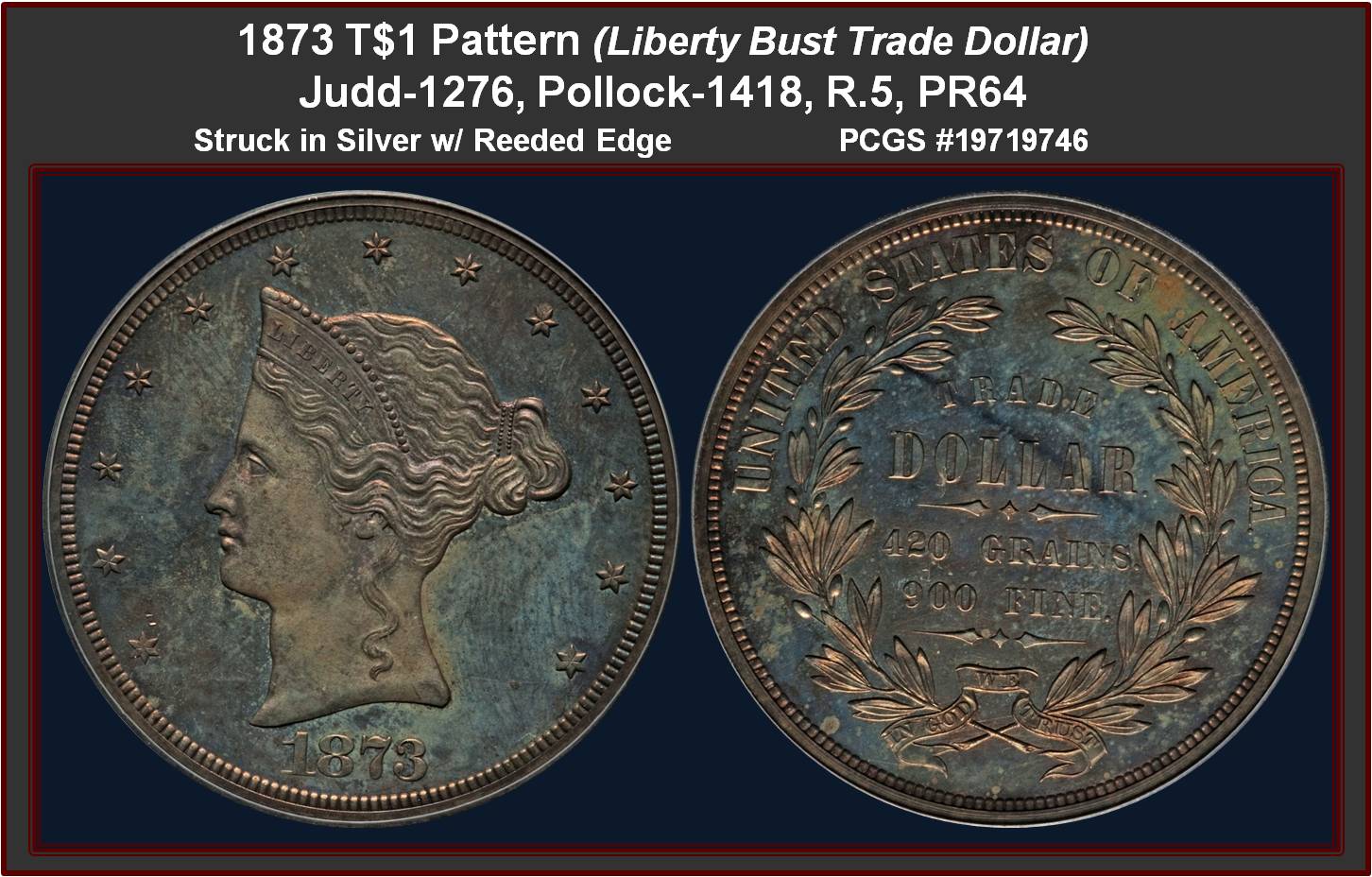
1873 1$ Trade
Judd-1276 Pollock-1418,
Rarity: R.5, (31-75 believe to be in existent), PR64
Struck in Silver with reeded edge.
Obverse: A William Barber design of the bust of Liberty facing left, with thirteen stars around and the date 1873 below. She is wearing a coronet inscribed LIBERTY and beaded along the top. Liberty's hair is tied in a knot encircled by a band of pearls.
Reverse: The denomination TRADE DOLLAR, the weight 420 GRAINS, and the quality of the metal 900 FINE, are inscribed within an olive wreath. The legend UNITED STATES OF AMERICA is above, and the motto IN GOD WE TRUST is on a scroll at the base of the wreath.
Comment: The surfaces of this piece show golden-orange patina and rose accents when held at the correct angle. Over-all nice eye appear with the even tone variations.
Provenance/ Appearances:
Heritage Mar 2016 Dallas / Lot #5158; Heritage Sept 2014 Long Beach / Lot #3581
|

|
|
View Coin
| J-1281 |
United States
|
T$1 1873 J-1281
|
PCGS PF 62
|

1873 1$ Trade
Judd-1281, Pollock-1423,
Rarity: R.4, PF62
Struck in silver with a reeded edge.
Obverse: The bust of Liberty faces left on the obverse, and her hair is coiled at the back of her head. The date 1873 is below; 13 stars ring the rim.
Reverse: An eagle holds his wing open, clutching three arrows in one claw and supporting a shield with the other. A ribbon inscribed IN GOD WE TRUST transverses the shield. 420 GRAINS, 900 FINE and TRADE DOLLAR are below; UNITED STATES OF AMERICA and E PLURIBUS UNUM--the latter in minuscule font--are above.
Comment::
The Year Trade Dollars became a reality: The Bailly design, one of many in the series of 1873 Trade dollar patterns
Provenance/ Appearances:
|

|
|
View Coin
| J-1293 |
United States
|
T$1 1873 J-1293
|
NGC PF 62
|
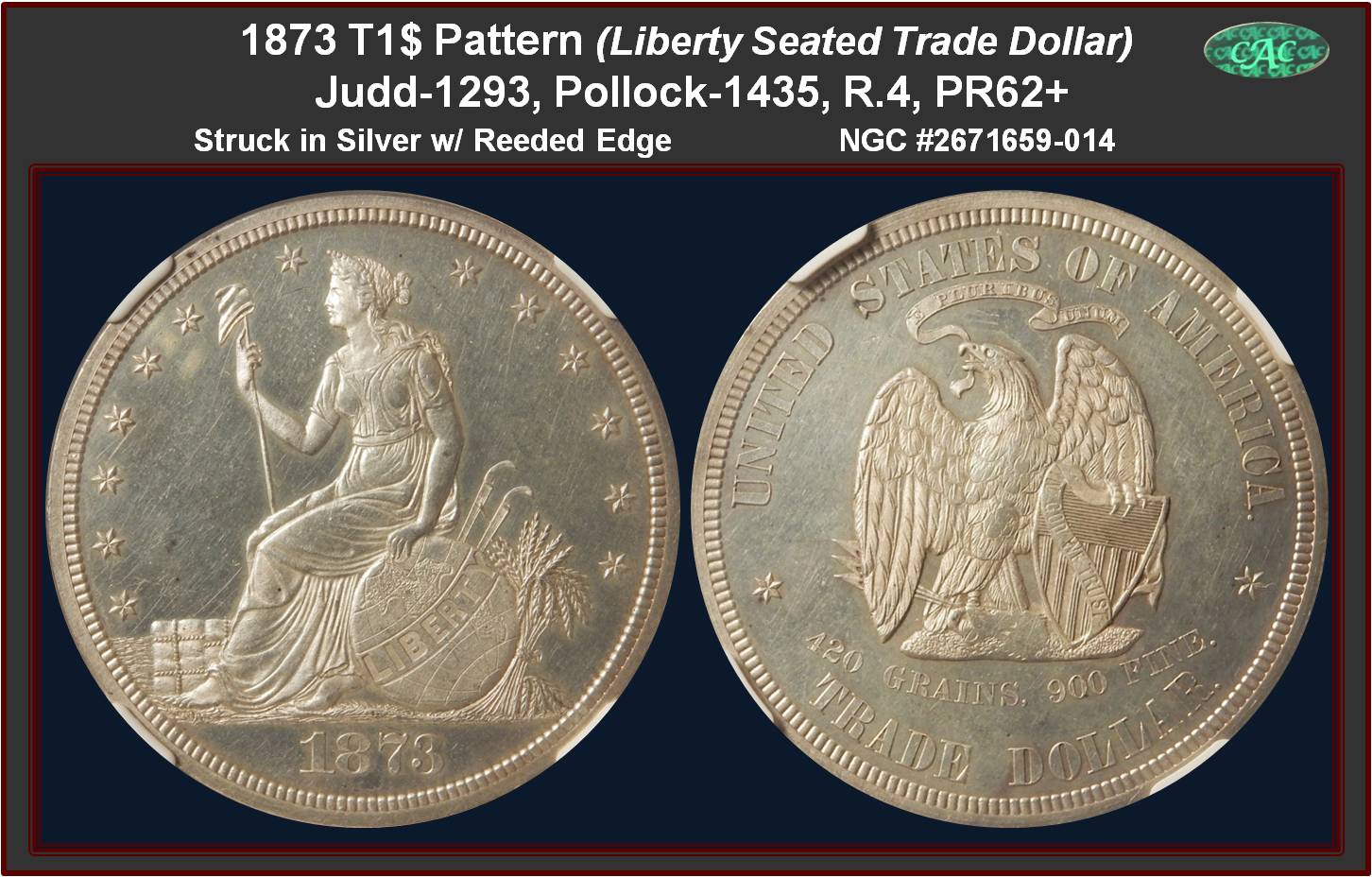
1873 1$ Trade
Judd-1293, Pollock-1435
Rarity:R.4, PR62+ CAC Endorsed
Struck in silver with a reeded edge
Obverse: The central figure of the obverse die is a seated Liberty facing left. Liberty holds a pole with Liberty cap, and is surrounded by a globe, cotton bales, a plow, and a sheaf of wheat. There is an arc of 13 stars at the border, with the date below.
Reverse: The reverse features an eagle standing on a rock, clutching three arrows and supporting a shield with his left talon. A ribbon across the shield carries the motto IN GOD WE TRUST. A banner in the eagle's beak is inscribed E PLURIBUS UNUM. Below the eagle are the specifications 420 GRAINS and 900 FINE. The peripheral inscriptions are UNITED STATES OF AMERICA and TRADE DOLLAR.
Comment:
The piece almost has a cameo effect with lovely smooth surfaces and a slight contrast with the fields.
Provenance/Appearances:
The Kentucky Collection
.
|

|
|
View Coin
| J-1310 |
United States
|
T$1 1873 J-1310
|
PCGS PF 62
|

1873 1$ Trade
Judd-1310, Pollock-1453
Rarity: R.4. PR62
Struck in silver with a reeded edge.
Obverse: William Barber Trade dollar pattern shows Liberty seated on the obverse wearing an Indian headdress, Liberty pole and cap in her right hand, left hand resting on a globe, and conjoined flags behind.
Reverse: The reverse has a small eagle in the upper half with most of the statutory legends above and below, two of which are on scrolls. 420 Grains and 999 FINE are below the eagle
Comment:
the obverse design is a copy of James Longacre pattern silver dollars obverses of 1870-1872.
This design type is known is five different varieties, including reeded-edge and plain-edge pieces struck in silver, copper, aluminum, and white metal. Of the five, the silver issue with the reeded edge (Judd-1310) is the most plentiful. These were sold as part of sets to collectors for 30$
Provenance/Appearances
|

|
|
View Coin
| J-1315 |
United States
|
T$1 1873 J-1315
|
PCGS PF 63 Cameo
|
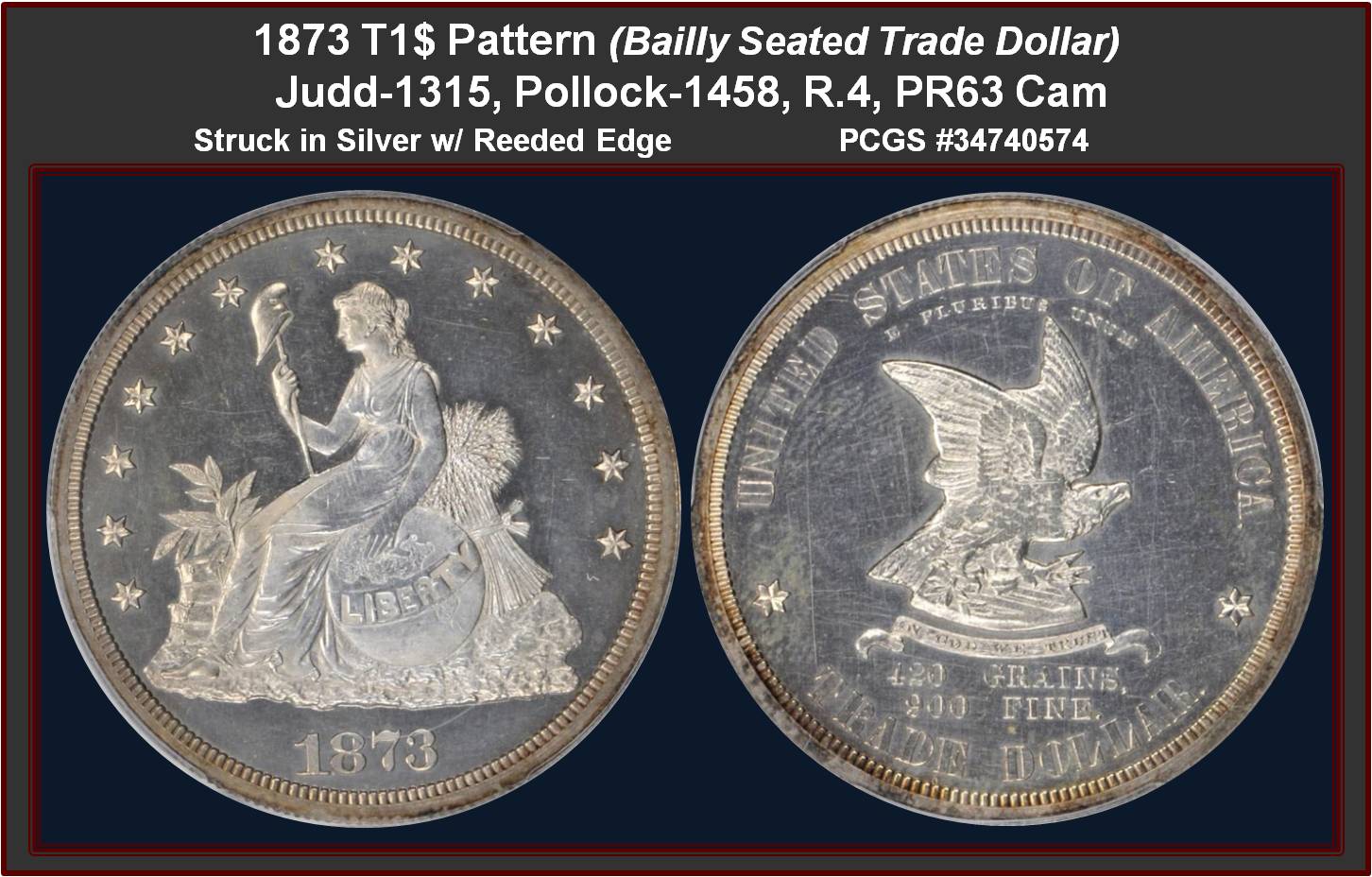
1873 1$ Trade
Judd-1315, Pollock-1458,
Rarity: R.4, PR63CAM
Struck in silver with a reeded edge.
Obverse: Bailly's Liberty design is seated left on the obverse with cotton bales, tobacco plants, and wheat sheaves around her. Her right (facing) hand supports a globe inscribed with LIBERTY while her left holds high a pileus cap.
Reverse: A small eagle atop a shield dominates the reverse with the inscriptions UNITED STATES OF AMERICA and E PLURIBUS UNUM above and 420 GRAINS, 900 FINE and TRADE DOLLAR below.
Comment:
The reeded edge variant of this pattern is by far the most obtainable of the silver, copper, and aluminum pieces struck. The fields are deeply reflective and establish the brilliant background for the frosty devices necessary for premium Cameo designation.
This design is one of the 6 pieces Trade Dollars sold in sets by the Mint
|

|
|
View Coin
| J-1322 |
United States
|
T$1 1873 J-1322
|
NGC PF 63
|

1873 1$ Trade
Judd-1322, Pollock-1465
Rarity R.4, PR63
Struck in Silver with Reeded Edge.
Obverse: Similar to the regular issue trade dollar design, although the right tip of the base upon which Liberty's portrait is located is longer and extends to the border.
Reverse: The reverse has a small eagle with spread wings clutches a group of three arrows in its left talon and an olive branch in its right talon. A scroll in the eagle's beak is inscribed with the Latin motto E PLURIBUS UNUM, and the inscription 420 GRAINS, 900 FINE is in the field below the eagle. The legend UNITED STATES OF AMERICA is above, and the denomination TRADE DOLLAR is below.
Comment:
With the authorization of the trade dollar, the engravers and die sinkers at the Mint prepared many sample designs for officials to inspect. The "Commercial Dollar" patterns of 1872 were followed by the trade dollar patterns in 1873; in 1873 18 different obverse and reverse die combinations were struck in various metals and edge variants, leaving a legacy of 54 different Judd numbers.
US Patterns .com indicated that this one of the types sold in6 piece sets for 30$
Provenance/Appearances:
|

|
|
View Coin
| J-1460 |
United States
|
S$1 1876 J-1460
|
NGC PF 63 BN
|

1876 $1 Sailor Head Dollar
Judd-1460, Pollock-1610
Rarity: High R.7, PR63 BN
Ex Olsen / Ewalt
Struck in copper with a reeded edge
Obverse: William Barber's Sailor Head design with a bust of Liberty facing left on a plain field with “IN GOD WE TRUST” in small letters and the date both below the bust. LIBERTY appears on a coronet in Liberty's hair. Her hair tied back with a ribbon
Reverse: The reverse has ONE DOLLAR within a wreath with UNITED STATES OF AMERICA at the top border and E PLURIBUS UNUM at the bottom border.
Comment:
Magnificent toned Proof. This pattern is a Low R.7. this piece was from the fame Olsen collection. The late B. Max Mehl thought so highly of this design, that he plated this piece with an enlarged illustration in the Fred Olsen collection catalog. A practice for only specific important pieces back in the forties and fifties.
While I and others may use the term Sailor Head for this piece it is somewhat different than the predecessors of the 5 & 10$ pieces J-1439 & J1444 where this piece is missing the collar that helps the bust to resemble sailor garb of that time frame.
Provenance/ Appearances:
Private Transaction Nov 2022, Priors:
- B. Max Mehl Nov 1944, (Fred E. Olsen Numismatic Auction) /Lot# 52,
- Stacks Nov 1965 (Ewalt Collection) /Lot #65,
- The Kentucky Collection, Great Collections Oct 2016 #391534
Plate coin for NGC Coin Explorer for J1460
|

|
|
View Coin
| J-1550 |
United States
|
S$1 1878 J-1550
|
PCGS PF 62
|

1878 Pattern Morgan Silver Dollar
Judd-1550, Pollock-1727
Rarity: High R.7 PR62
Struck in Silver with reeded Edge
Obverse: A head of Liberty faces left with the Latin motto E PLURIBUS UNUM above and the date 1878 below. There are 13 stars at the border arranged seven left, six right. Liberty is wearing a cap, the band of which is inscribed LIBERTY and ornamented with ears of wheat, cotton leaves and bolls. The design is nearly identical to that which the Mint adopted for regular issue Morgan dollar production.
On this particular die, the wheat ear is distant from the letter R in PLURIBUS and the small leaf between the two wheat ears nearly touches the base of the adjacent letter I.
Reverse: The motto IN GOD WE TRUST is inscribed in the field above the eagle. The legend UNITED STATES OF AMERICA is at the upper border, the denomination ONE DOLLAR at the lower border. This design is also very similar to that adopted by the Mint for regular issue Morgan dollar production, although there are only three leaves on the olive branch.
Comment: Judd-1550 is the second prototype Morgan dollar, the so-called "Notched Wing" variety that is distinguished from the first prototype (Judd-1550a) on which the bottom of the wings are shaped like a fan.
Both sides exhibit mottled light gray toning over smooth surfaces. Modest cameo contrast is seen between mirrored fields and softly frosted design elements. Several shallow scrapes around Liberty's eye are noted, and were it not for these features the grade returned by PCGS might have been as high as Proof-64. This is a rare type, with an extant population of fewer than half a dozen specimens (per uspatterns.com).
Provenance/ Appearances:
Stacks Aug 2020 Auction - Session 3 /Lot #3159; Prior Provenance: From Stacks (American Numismatic Rarities') Aug 2004 Allison Park Collection sale /Lot #1298.
|

|
|
View Coin
| J-1554 |
United States
|
S$1 1878 J-1554
|
NGC PF 63
|

1878 $1 Barber Designed Dollar
Judd-1554, Pollock-1733 (Pollock List the P1733 as a Rarity R.6 - w/ 13 - 30 in existence)
Rarity: R.5, PR63 CAC Endorsed:
Struck in silver wit Reeded Edge
Obverse: :Liberty wears a beaded coronet and faces left. The stars are arranged 7 x 6, separated by IN GOD WE TRUST with the date below.
Reverse: :Features a standing eagle with spread wings, clutching an olive branch and arrows. E PLURIBUS UNUM is above in gothic letters. The border displays UNITED STATES OF AMERICA and ONE DOLLAR with the legends separated by two stars.
Comment: :
This is the Pollock variety with star 13 distant from the curl and the upright of the B in PLURIBUS centered under the second T in STATES. The fields are brightly reflective and each side shows light, scattered reddish-golden toning with a trace of blue around the margins.
Provenance/Appearance:
From The Indian Rocks Collection Heritage April 2016 CSNS Signature Auction - Chicago / Lot #5622; Prior possible Stacks Portion July Auction 87 / Lot #839
|

|
|
View Coin
| J-1554b |
United States
|
S$1 1878 J-1554b
|
PCGS PF 65 Red Brown
|

1878 $1 Barber Designed Dollar
Judd-1554b, Pollock-1746
Rarity: High R.7, PR65RB CAC Endorsed
Pollock’s reference guide plate coin Fig 481
Struck in copper wit Reeded Edge
Obverse: Liberty wears a beaded coronet and faces left. The stars are arranged 7 x 6, separated by IN GOD WE TRUST with the date below.
Reverse: An eagle with wings spread, holding an olive branch and three arrows. The legend is above and the denomination is below, with E PLURIBUS UNUM in the field above the eagle. The Pollock sub-variety with the B in PLURIBUS beneath the left edge of the E in STATES ND and there are no stars on either side of the eagle (@ 4:00 and 8:00 positions) as on previous versions of the reverse. The l in pluribus is under the left edge of S in states. The m in unum is centered beneath ME in AMERICA
This piece was once classified as Judd-1555
Comment:
At least three copper examples are known according to USPatterns.com. There is only these copper specimen's noted. While silver, aluminum and/or white metals strikes may have been struck - none have been seen.
Technically the color designation is correct, but the slight lime-green iridescence present in the fields does little to impede the overall visual appeal of this magnificent pattern.
354.4 grains
Provenance/Appearance:
From Great Collections April 2024 priors Ex: Milton G. Cohen Collection (Bowers and Merena, 1/1985), lot 514 (listed as J1555); Russell Logan and Gilbert Steinberg Collections (Bowers and Merena, 11/2002), lot 4430 (listed as J1555); Bob Simpson Collection (Heritage, 8/2010), lot 5717 (Listed as J1555); Heritage May 2017, Lot # 4429; Heritage Sept 2017 Long Beach Lot # 4129
Plate coin figure 481 in Pollock’s refence guide
Judd 8th edition Plate
|

|
|
View Coin
| J-1557 |
United States
|
S$1 1878 J-1557
|
PCGS PF 60
|

1879 1$ Goloid Dollar
Judd-1557, Pollock-1749
Rarity: Low R.6, PR60 CAC Endorsed
Struck in silver with reeded edge
Obverse: Features the Head of Miss Liberty facing left, with E PLURIBUS UNUM above and the date 1878 below. Miss Liberty is wearing a cap inscribed LIBERTY in incuse letters. The cap band is ornamented with ears of wheat, cotton leaves and bolls. There are thirteen stars at the border arranged seven left and six right.
Reverse: On the reverse is the inscription GOLOID /1 - G. / 24 - S. / .9 FINE. / 258 GRS. within a circle of thirty eight stars. The legend UNITED STATES OF AMERICA is at the border above, and the denomination ONE DOLLAR is below.
Comment:
A pleasant piece for the grade with faint reflective surfaces under a ting of pale toning throughout piece.
Provenance/Appearance:
Privately purchased in 2016; Originally slabbed in a OGH and believed off market for years

|

|
|
View Coin
| J-1559 |
United States
|
S$1 1878 J-1559
|
PCGS PF 66 Red Brown
|

1878 $1 Goloid Dollar,
Judd-1559, Pollock-1751,
Rarity: Low R.7, PR66 RB
Ex: Newman
Struck in copper with reeded edge
Obverse: Features the Head of Miss Liberty facing left, with E PLURIBUS UNUM above and the date 1878 below. Miss Liberty is wearing a cap inscribed LIBERTY in incuse letters. The cap band is ornamented with ears of wheat, cotton leaves and bolls. There are thirteen stars at the border arranged seven left and six right.
Reverse: On the reverse is the inscription GOLOID /1 - G. / 24 - S. / .9 FINE. / 258 GRS. within a circle of thirty eight stars. The legend UNITED STATES OF AMERICA is at the border above, and the denomination ONE DOLLAR is below.
Comment:
Judd-1559 was William Barber's third goloid dollar design of the year. The circle of 38 stars on the reverse, one for each state in the Union at that time, was suggested by Dr. Wheeler Hubbell, who had patented the goloid alloy for coinage. Andrew Pollock accounted for just five examples of this rare pattern in his series reference, and one of them was held by the J.C. Mitchelson Collection in the Connecticut State Library. USPatterns.com estimates more than half a dozen specimens may be extant.��The well-preserved surfaces of this Premium Gem display a mixture of original red, crimson, and light brown patina. The design elements are well-detailed and the fields are brightly reflective, under the toning. Outstanding eye appeal complements the high technical grade
Provenance/Appearance:
From The Cape Coral Collection, Heritage Jan 2024 FUN / Lot #4204 Priors:
Ex Eric P. Newman, Heritage Apr 2013 CSNS - Chicago / Lot #4014 As NGC66 RB with CAC Endorsement
|

|
|
View Coin
| J-1562 |
United States
|
S$1 1878 J-1562
|
PCGS PF 67 Red Brown Red Brown
|

1878 $1
Judd-1562, Pollock-1753
Rarity: High R.6, PR67 RB CAC Endorsed
Ex: Simpson.
Struck in copper with a reeded edge
Obverse: The obverse bears William Barber's Liberty Head design facing left with E PLURIBUS UNIM above and the date below. Miss Liberty is wearing a cap inscribed LIBERTY in incuse letters. The cap band is ornamented with ears of wheat, cotton leaves and bolls. Thirteen stars are at the border (7 left / 6 right).
Reverse: Inscribed within a laurel wreath, GOLOID / 1 GOLD. / 24 SILVER / .9 FINE / 258 GRS. ONE DOLLAR and the national identification are at the periphery.
Comment: The various metallic compositions that Dr. William Wheeler Hubbell patented as "goloid" in 1877 were so much wishful thinking, and they appear not have inspired much enthusiasm, either at the Mint (save for Mint Director Linderman, ever eager to strike off-metal designs for his own benefit) or Congress.��Although they had a predetermined fixed (melt) value of 24 parts of silver to one part of gold (the official federal ratio at the time), they all allowed for considerable deviance from those ratios (for example, the ratio of silver to gold could range for 20:1 to 30:1), and they all had to have a harder metal, copper, alloyed with the soft gold and metal elements (as today) to produce .900 fine (or "coin silver") blanks of sufficient hardness and durability.��But beyond technical limits and qualifications, they had a more basic flaw: A small amount of gold, despite assurances that might be stamped on the coin, was undetectable from all-silver or silver-copper alloys, and thus subject to public mistrust and/or private counterfeiting.��This pristine Superb Gem proof displays attractive gold and amber dominating against red and light purple hues. The surfaces are sharply struck throughout and free of mentionable distractions.
Provenance/Appearances:
From the Bob Simpson Collection, Heritage Nov 2020 Signature Auction / Lot #3257; Prior
American Numismatic Rarities Aug 15 2004 The Classics Sale: The Allison Park Collection / Lot 1299 (as NGC 67RB);
Heritage Jan 2001 F.U.N. Signature Sale / Lot #8557 (NGC67RB),
Superior Mar 2000 (ANA 2000) Lot 677 (NGC67RB),
Heritage Aug 1998 (ANA Portland) / Lot #5157 (NGC67RB)
Stacks Feb 1978 ( Goshen Collection ) / Lot 765
|

|
|
View Coin
| J-1563 |
United States
|
S$1 1878 J-1563
|
PCGS PF 63
|

1878 $1 Goloid Metric Dollar
Judd-1563, Pollock-1754
Rarity: Low R.6, PR63
Struck in Goloid w/ Reeded Edge
Obverse: Liberty faces left, with cap adorned with wheat ears, cotton leaves and bolls, eponymously inscribed in incuse letters. There are 13 stars ringing the rim, with the Latin motto above and date below.
Reverse: On the reverse the center reads GOLOID / METRIC / 1--G. / 16.1--S. / 1.9--C. / GRAMS 14.25. within a circle of 38 stars. UNITED STATES OF AMERICA is above, 100 CENTS below.
Comment:
Allegedly struck in goloid alloy, but possibly silver as metallurgical analysis has not been conducted on these pieces,
In spite of the reddish-yellow patina seen across each side, the underlying mirrors in the fields remains bright and greatly enhances the vibrancy of this piece.
The obverse especially shows numerous tiny (minute) planchet flakes scattered about
Provenance/Appearances:
Heritage Oct 2019 Dallas / Lot #4217
|

|
|
View Coin
| J-1605 |
United States
|
S$1 1879 J-1605
|
PCGS PF 63
|

1879 $1
Judd-1605, Pollock-1801
Rarity: Low R.7, PR63 CAC Endorsed
Ex: Simpson.
Struck in silver with a reeded edge
Obverse: Head of Liberty facing left with her hair tightly coiled about her head in a bun, with two flowing ribbons in back and a beaded headband inscribed LIBERTY. IN GOD WE TRUST is above and the date 1879 below. Thirteen stars are arrange on each side with 7 left and 6 right.
Reverse: An eagle with spread wings with an Oliva branch in the right talon and 3 arrows in the left. A laurel wreath wraps around underneath the eagle. UNITED STATES OF AMERICA is around the rim -- the letters irregularly spaced -- and the denomination ONE DOLLAR is below the wreath. The motto is in small letters above the eagle.
Comment:
The Judd reference calls this William Barber obverse similar to the famous "Washlady" design, but there are also similarities to the Coiled Hair stella obverse
Each side is mostly brilliant with the occasional dab of toning around the letters and other devices. Light hairlines and a few minor scuffs account for the grade.
Provenance/Appearances:
From the Bob Simpson Collection Heritage April 2021 Central States Signature Auction / Lot #4290; Prior Stacks/ANR June 2004 The Classics Sale /Lot 1680 (as NGC PR62); Mid-American Rare Coin May 1985 GNA / Lot # 826
|

|
|
View Coin
| J-1612 |
United States
|
S$1 1879 J-1612
|
NGC PF 63 BN
|

1879 $1 Morgan Dollar
Judd-1612, Pollock-1808
Rarity: Low R.7, PR63 BN
Struck in copper with a reeded edge.
Obverse: This issue features the adopted Morgan dollar obverse
Reverse: An alternative large perched eagle holding an olive branch (with seven leaves) and three arrows. Around the reverse border are the legends: UNITED STATES OF AMERICA / ONE DOLLAR.
Comment:
Some observers had called the eagle on the adopted reverse "scrawny."
Most of each side is deep brown with an interesting accent of green patina over the eagle on the reverse.
Provenance/Appearances:
From Heritage Sept 2020 Signature Auction / Lot #3504; Prior ANR Oct 2004 (The Pevehouse & Davis Collections) /Lot # 1053, as NGC63 BN (Passed) and reference to Bower & Ruddy Jan 1983 (Roy Harte Collection, Part 3) /Lot #2183 and accompanied by original ticket. Proof Cleaned (Photos also confirm same piece)
|

|
|
View Coin
| J-1614 |
United States
|
S$1 1879 J-1614
|
PCGS PF 64 Brown
|

1879 $1 Morgan Dollar
Judd-1614, Pollock-1810
Rarity: Low R.7, PR64 BN
Struck in copper with a reeded edge
Obverse: The obverse is the regular die for the Morgan silver dollar.
Reverse: Roughly similar to the Morgan reverse, but the eagle's wings are lowered rather than raised, with the eagle somewhat larger and the body shaped differently--less tapered. ONE DOLLAR is beneath in tiny letters, and IN GOD WE TRUST encircles the eagle's head, but not in a script font as on the regular issue. UNITED STATES OF AMERICA is roughly the same appearance as on the final product.
Comment:
A very richly and originally toned example of this Morgan Dollar
The coppery surfaces have a watery reflection under a deep layer of chestnut, violet, olive, and rose iridescent hues. Sharply struck throughout, the devices have a wonderful frost. The eye appeal is excellent
Provenance/Appearance:
From Legend Rare Coin Auctions May 2020 Legend Rare Coin Auctions / Lot #305
|

|
|
View Coin
| J-1617 |
United States
|
S$1 1879 J-1617
|
PCGS PF 62
|

1879 $1 Metric Dollar
Judd-1617, Pollock-1813
Rarity: R.4, PR62 :
Struck in goloid composition with a reeded edge
Obverse: :William Barber chose a head of Liberty facing left as the central obverse motif, with a coronet inscribed LIBERTY, the hair tied in a bun at the back and flowing down to the shoulder. E PLURIBUS UNUM appears at the top border with the date below, seven stars left, and six stars right.
Reverse: :The legend and denomination are placed at the top and bottom border with a wreath of corn and cotton. A cartouche contains the motto DEO EST GLORIA and a circle inside the wreath frames the four line inscription 895.8 S. / 4.2--G. / 100--C. / 25 GRAMS. - The goloid alloy composition (Silver Gold Copper)
Comments: :
A few scrapes and hairlines on each side limit the grade of this light gray proof pattern, with peripheral lilac and gold toning.
Provenance/Appearance:
From Private Transaction Dec 2011 Houston Money Show; prior Heritage Jan 2010 Orlando, FL FUN Auction / Lot #3769; Heritage Jan 2007 Orlando, FL (FUN) Signature Auction / Lot #1579
|

|
|
View Coin
| J-1618 |
United States
|
S$1 1879 J-1618
|
PCGS PF 65
|

1879 $1 Metric Dollar,
Judd-1618, Pollock-1813,
Rarity: R.5, PR65 CAC Endorsed
Ex: Harry W. Bass, Jr. Collection
Struck in Silver with a reeded edge
Obverse: William Barber chose a head of Liberty facing left as the central obverse motif, with a coronet inscribed LIBERTY, the hair tied in a bun at the back and flowing down to the shoulder. E PLURIBUS UNUM appears at the top border with the date below, seven stars left, and six stars right.
Reverse: The legend and denomination are placed at the top and bottom border with a wreath of corn and cotton. A cartouche contains the motto DEO EST GLORIA and a circle inside the wreath frames the four line inscription 895.8 S. / 4.2--G. / 100--C. / 25 GRAMS. - The goloid alloy composition (Silver Gold Copper)
Comments: This is a collectible pattern with several hundred pieces known, according to USPatterns.com. Mostly silver-gray surfaces exhibit whispers of golden color. Razor-sharp and minimally marked for the grade.
Interesting to note that when this piece was housed on the ANA Museum for 30 years Harry Bass had Cataloged it as a J-1617 ( Goloid) piece and not the Silver J-1818 composition PCGS evaluated and labelled the piece. This reinforced the concept that these goloid pieces should be metallically tested.
Provenance/Appearance:
From The Harry W. Bass, Jr. Core Collection, Part II. Heritage Jan 2023 Fun Lot # 9099, Bass purchased from Stack's (6/26/1970).
|

|
|
View Coin
| J-1619 |
United States
|
S$1 1879 J-1619
|
NGC PF 65 BN
|

1879 $1 Metric Dollar
Judd-1619, Pollock-1814
Rarity: Low R.7, PR65 BN.
NGC Coin Explorer Plate Coin for J1619
Struck in copper with a reeded edge.
Obverse: William Barber chose a head of Liberty facing left as the central obverse motif, with a coronet inscribed LIBERTY, the hair tied in a bun at the back and flowing down to the shoulder. E PLURIBUS UNUM appears at the top border with the date below, seven stars left, and six stars right.
Reverse: The legend and denomination are placed at the top and bottom border with a wreath of corn and cotton. A cartouche contains the motto DEO EST GLORIA and a circle inside the wreath frames the four line inscription 895.8 S. / 4.2--G. / 100--C. / 25 GRAMS. - The goloid alloy composition (Silver Gold Copper)
Comment: A meticulously struck Gem that is richly toned in orange, sea-green, and rose-violet colors. A pair of minor handling marks on Liberty's neck are all that precludes a higher grade.
Commentary of interest below was extracted from The Stacks Nov 2007 Caterlog for lot 1180 ….
”The goloid metric alloy was debated in Congress, and much can be found concerning it in the annals of that body. Briefly, the idea was that by adding equal value (but not weight) of silver and gold, a coin would be created that would be politically ideal. This was a time when "Silverites," as they were called, were bemoaning the collapsed state of the market for that metal, with distress in Nevada and other silver-mining states, at the same time new strikes were being found. There was no longer a market for coinage silver in Europe, as that standard had been dropped. Coinage use for silver metal was negligible except for the boondoggle of the Bland-Allison Act of February 28, 1878, which mandated that Uncle Sam make Morgan silver dollars. Still, those who preferred "real money," or gold, felt that Morgan dollars were a waste of Federal funds, and that the only acceptable standard should be gold. This went into the forefront as the most burning political issue of the next decade, extending all the way to 1896, when it was the issue in the presidential campaign that year. Goloid metal of gold and silver was predominantly silver by weight, to which mix 10% copper was added as an alloy for strength. The result was not distinguishable from silver except by elemental analysis. The concept was rejected when the Treasury Department protested that neither the public nor anyone else, except for those with a scientific inclination, would be able to tell whether a dollar was made in goloid alloy or in regular silver alloy. This would be a boon for counterfeiters, who would need to use less metal overall.”
Provenance/Appearances:
Private Sale Jan 2022: Prior
- Heritage June 2008 West Palm Beach, FL (Summer FUN) / Lot #1758 (Passed)
- Stacks Nov 2007 Sale (The Amherst & Waccabuc Collections) / Lot #1180 (Passed) From the Cat Daddy Collection;
- Heritage Feb 2005 Long Beach (Mike Jacobson Collection.) / Lot #9870
- Heritage Mar 2004 Portland, OR Signature Sale / Lot #6671
- Heritage May 2004 Exclusively Internet Auction / Lot #13778
- Heritage April 2004 / Lot #12367 (passed)
- RARCOA Aug 1980 ( Auction 80) Lot # 1858 ($2700)
|

|
|
View Coin
| J-1620 |
United States
|
1$ 1879 J-1620 Simpson
|
PCGS PF 65
|

1879 $1 Metric Dollar
Judd-1620, Pollock-1815
Rarity: R.8, PR65
Ex: Simpson.
Struck in aluminum with a reeded edge.
Obverse: William Barber chose a head of Liberty facing left as the central obverse motif, with a coronet inscribed LIBERTY, the hair tied in a bun at the back and flowing down to the shoulder. E PLURIBUS UNUM appears at the top border with the date below, seven stars left, and six stars right. This design is similar to that used on Barber's half union patterns of 1877.
Reverse: : The legend and denomination are placed at the top and bottom border with a wreath of corn and cotton. A cartouche contains the motto DEO EST GLORIA and a circle inside the wreath frames the four line inscription 895.8 S. / 4.2--G. / 100--C. / 25 GRAMS. - The goloid alloy composition (Silver Gold Copper)
Comment:
The commonly encountered examples of this Metric dollar design are found in silver or goloid. A dozen pieces are known in copper. "At least 4 known" in aluminum, according to USPatterns.com these are traced to be
1) Maris, Garrett-JHU, B/R 3/80 Garrett II
2) Bowers and Ruddy 2/78
3) Paramount 3/81
4) Spink/Smythe Magnolia 5/11, Simpson-Heritage 9/20, Heritage 8/22 ANA - PCGS65 with lamination over eye.
As with most aluminum patterns, the fields are deeply reflective and the devices noticeably frosted. A few shallow planchet lamination's are seen on the obverse including one diagnostic over the eye (these are common occurrence on aluminum) and a couple of whitish spots are located in the center of the reverse. Fully struck.
This pieces was featured in an article in Coin Week article ‘The Magnolia Collection of Early U.S. Gold Coins, late 19th century Patterns, Trade Dollars and more” . May 2011 by Greg Reynolds 
“… An 1879 Goloid Metric Dollar, struck in aluminum, is a little more distinctive. It is a conceptual pattern for a new design and alloy for dollar coins. Although this particular piece was struck in aluminum, a silver-gold-copper alloy was being considered. Probably, only two representatives of this pattern issue survive. This piece has wonderful natural color and virtually zero contact marks. I enjoyed viewing it. It brought $60,475, which I take to be a very strong price. … “
COIN WEEK May 2011
Provenance/Appearances:
From Heritage Aug 2022 / Lot #5291; Prior
- Ex: Bob Simpson , Important Selections from The Bob R. Simpson Collection, Part I (Heritage, 9/2020), Lot #10328;
- Spink/Smythe Magnolia May 2011 Lot #27
|

|
|
View Coin
| J-1622 |
United States
|
S$1 1879 J-1622
|
NGC PF 63
|

1879 1$ Goloid Metric Dollar
Judd-1622, Pollock-1818
Rarity: Low R.7 PR63
NGC Coin Explorer Plate coin for J1622
Struck in Golloid with reeded edge
Obverse: George Morgan's austere head of Liberty left, hair tightly coiffed, ribbon in hair reads LIBERTY
Reverse: UNITED STATES OF AMERICA ONE DOLLAR around an agricultural wreath, with composition as “ 895.8 S. / 4.2-G. / 100-C. / 25 GRAMS” on four lines within a beaded circle within the wreath.
Comment:
There are a dozen or so examples of this metallic variant, but it is not known if any are actually goloid or if they are all silver. Pieces were also struck in copper, aluminum, and white metal. This example is deeply mirrored with a slight accent of pale gold over each side.
Provenance/ Appearances:
From The Pacific Rim Collection, Heritage Nov. 2021 Signature® Auction Dallas / Lot #3779; Prior David Lawrence Jul 2018 Internet Auction #1021 / Lot #4390
|

|
  
 | Loading… |
|